 By Staff By Staff
January 11, 2015
BURLINGTON, ON
Halton Regional Police report that on Saturday January 3rd 2015 at approximately 6:00 pm, a lone male suspect attended the Apple Store at Mapleview Mall in Burlington and proceeded to steal $4500 worth of Apple products before fleeing the store.
A mall security officer quickly located and chased the suspect through the mall but lost sight of the male as he ran outside.
As the security officer continued to check the parking lot, the suspect emerged from behind a vehicle and pepper sprayed the security officer in the face and made good his escape.
The investigation was continued by members of the Burlington Criminal Investigations Bureau and as a result, the suspect was identified as Qasim Mohamed CHOWDHURY (30 years) of Epps Cr. in Ajax.
On January 6th 2015, the suspect was arrested and held for bail on charges of theft under $5000, assault with a weapon and administering a noxious substance.
The suspect was held for a bail hearing was put over to January 14th at Milton Court.
Any witnesses who have not yet spoken to police or anyone with information about this investigation are asked to contact the Burlington Criminal Investigations Bureau at 905 825-4747 ext. 2316 or Crime Stoppers at 1-800-222-8477 (TIPS), or through the web at www.haltoncrimestoppers.com, or by texting “Tip201” with your message to 274637 (crimes).

 By Pepper Parr By Pepper Parr
January 10, 2015
BURLINGTON, ON
Update: An observant reader advised us that: The City of Burlington tweeted out just a few hours ago that the Mayor was looking for a new Chief of Staff. The tweet linked to that job postings page. Not sure if the job had been posted in the fall or if was an appointment. Maybe there was a problem with the process? Not sure what it means.
Mayor Goldring has staffed up his office and now has Frances Grano serving as Chief of Staff; Tina Depko-Denver, former city hall reporter for the Post now serving as his Communications Assistant and Corry Holloway serving as the Assistant to the Mayor’s Office
 Grano is described as a business performance advisor with two decades of experience with the Ontario government. Grano is described as a business performance advisor with two decades of experience with the Ontario government.
She has been with Burlington since 2009 and has worked at the provision of Information Technology strategic consulting services, ensuring that solutions meet the needs of the business. Manages relationships with IT customers and delivers project management services on behalf of the ITS department.
Granos most recent assignment was as part of the team that brought Results Based Accountability to the city. Granos worked with the service owners in departments to align performance measurement and business process improvement with strategic goals and objectives. Her objective was the developing and maintaining performance measurement and business process management frameworks and related networks that link these aspects of the corporation together.
The team the Mayor has supporting him this term is significantly different than the one he had during his first term. Will it make a difference? It could.

 By Walter Byj By Walter Byj
January 10, 2015
BURLINGTON, ON
The initial 2015 meeting of the Halton District School Board continued the ongoing process of how to make the pursuit of an education easier, more fun and more rewarding.
 Halton District School Board chair Kelly Amos represent constituents in Oakville. Halton School Board Chair, Kelly Amos, recommended that the HSTS (Halton Student Transportation Services) do a study into the start times of high school students from the current time to a new time of between 8:45 and 9:15 am.
Any such change in time would require realigning busing within the system. After a brief discussion, the board passed the motion requesting a report from the HSTS sometime in March.
They then passed an additional motion that called for the Director of Education to establish an ad hoc committee of trustees and staff to investigate a strategy to regularly recognize staff, student, community partnership and volunteer achievements. Recognition and positive feedback are always useful, but the bar should be set high.
This was followed with a presentation from Lucy Veerman, Superintendent of Business Services and Treasurer, on the revised estimates of the 2014/2015 operating budget. Lots of numbers, the good news is that the revised budget is showing a surplus.
 Any change in school starting times will mean major changes to bus schedules. Gerry Cullen, Superintendent of Facility Services followed with the status of the “Close the Gap” program. This program was initiated to realize and address the gaps between older and newer schools to meet program delivery needs. Priority would be given to the following projects:
1. Water bottle filling stations
2. Support for installation of classroom projection equipment (IT)
3. Library Services
4. Air conditioning and electrical upgrades to second and third floor area of schools
5. Special education rooms
Approximately $14.4 million dollars was allocated to the project.
A more detailed article will follow shortly with a dollar breakdown and rationale for the above programs along with the affected Burlington schools.
It was a two and a half hour meeting – that went reasonably well.

 By Pepper Parr By Pepper Parr
January 9, 2015
BURLINGTON, ON.
The promise is being kept.
The Burlington Performing Arts Centre is doing more and more in the way of community programming. June Cash is nice, if you like that kind of stuff, but there are thousands of people in the city that want to do more than buy a ticket and watch. They want to do.
 Bhattacharya and Laberge- Côté’s working the stage And if dance is your thing there are a series of dance classes being offered in the next couple of months. This pilot initiative aims to increase the range and diversity of dance available to communities in Ontario outside of Toronto. From dance classes and workshops to artists in residence to the presentation of dance work from leading Ontario-based professional choreographers, Ontario Dances will offer the public and professionals alike the opportunity to participate in dance at all levels.
You must be registered to take part in any of the classes. You register. Links are set out below for registration. Each class has a different registration link.
Funded by the Ontario Arts Council’s Ontario Dances Program which seeks to have more live dance performances in Ontario communities and more people engaged, interested and invested in dance at a local level in our province.
There are four different classes:
Master Dance Class with Rosemary James
Creative Process Workshop with Christopher House
Contemporary Collaboration –
Contemporary & Classical Bharatanatyam Technique
 Master Dance class The Master Dance class will be led by Toronto Dance Theatre Rehearsal Director Rosemary James for young dancers. Participants must be 14 years of age or older with a minimum of 2 years of dance experience.
Maximum Participants: 20
All participants MUST be registered.
Register for this class here
Creative Process Workshop with Christopher House
Sunday, January 25, 2015 (1pm – 4pm)
in the Marshalling Room
An interactive working session aimed at exploring the creative process underlying the development and production of choreography. Christopher will present his approach to the creative process, particularly as it relates to his experience creating new works. During the session, he will engage participants in a variety of creative and/or choreographic exercises aimed at fostering their artistic development, and may also explore the different performance goals and/or production considerations relevant to various forms of dance and theatre.
Led by Toronto Dance Theatre Artistic Director Christopher House.
Participants must be 16 years of age or older with a minimum of 2 years of dance experience.
Maximum Participants: 20
All participants MUST be registered.
Register for this class here
Choreography & Collaboration
Saturday, February14, 2015 (1pm – 3pm) in the Marshalling Room
This workshop is ideal for dancers with training in EITHER contemporary dance (including jazz, modern, ballet) or classical Indian dance styles. Bhattacharya and Laberge-Côté with backgrounds in bharatanatyam and modern dance have been collaborating for over a decade. They have developed a specialized approach to dance training that transcends perceived boundaries of form and technique. During the afternoon session participants will be led through phrases of Bhattacharya & Laberge- Côté’s work Akshongay, giving them the opportunity to work with established choreographers in a rehearsal like process. The class culminates by delving into the creative process as the participants are guided through tried and tested methods of collaboration.
Participants must be 16 years of age or older with a minimum of two years of dance experience. Ideally participants would take both classes (10am & 1pm).
Maximum Participants: 20
All participants MUST be registered.
Register for this class here.
Contemporary & Classical Bharatanatyam Technique
Saturday, February14, 2015 (10am – 12pm)
in the Marshalling Room
Participants must be 16 years of age or older with a minimum of 2 years of dance experience.
Ideally participants would take all both classes (10am & 1pm).
Maximum Participants: 20
All participants MUST be registered.
Register for this class here.
 There have been some incredible performances on the stage of the Performing Arts Centre, The Performing Arts Centre has put son some wonderful dance productions in the past. Hopefully the Ontario Arts Council pilot Dance Outreach program will prove to be a resounding success – and we will see more dance on that stage.

 By Pepper Parr By Pepper Parr
January 8, 2015
BURLINGTON, ON
City council will meet for the first time this year on Monday morning of next week to review the first draft of the 2015 budget.
It will be interesting to watch how Mayor Goldring manages to bandage the wounds that were inflicted when the council he leads trashed the recommendations he made on appointments to Boards and Committees.
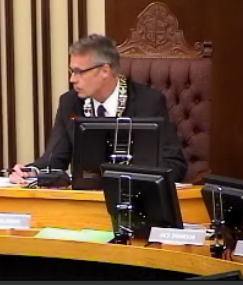 Does Mayor Goldring now lead a Council that is headed for a string of 4-3 votes with Councillor Dennison being the swing vote. Has it really come to this? Those recommendations were not something the Mayor scribbled on the back of an envelope and gave to the Clerk. They were the result of discussion with every member of council.
While the Mayor has just one vote, he is seen as the first among equals. Citizens expect him to lead and he certainly led when he put together his list.
That his Council trashed his recommendations and put forward three amendments that stripped Councillor Meed Ward of much of her board and committee work is disturbing to say the least. There is the very real possibility that the Mayor will be seen as a lame duck the first month into his four year term.
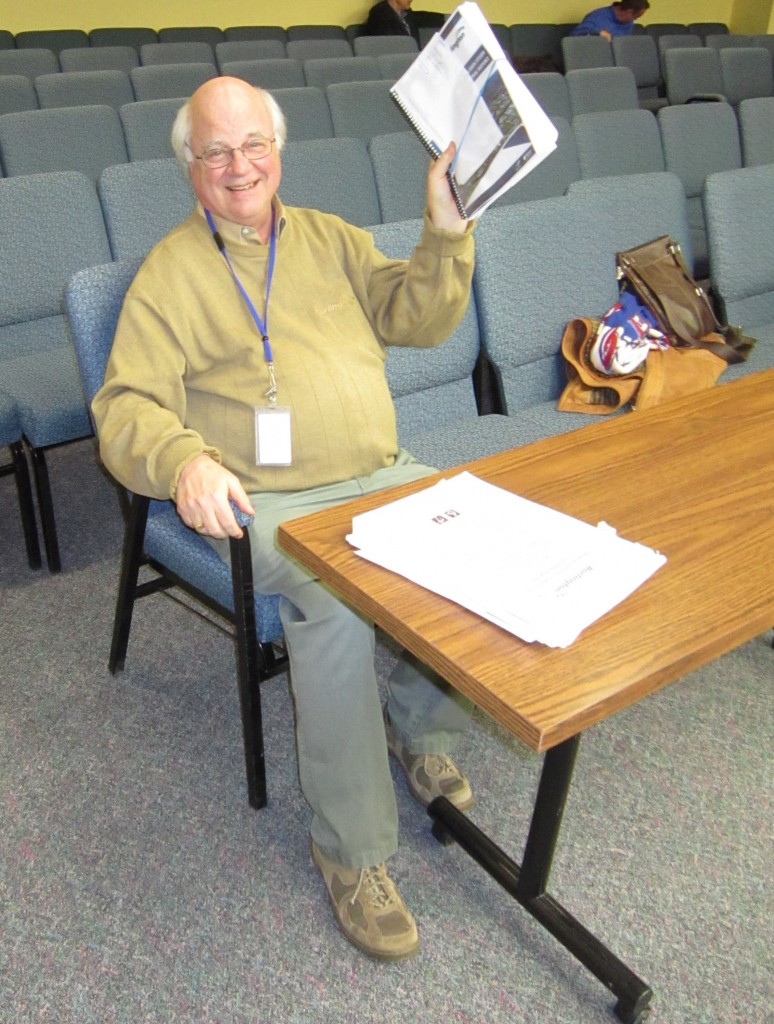 Councillor John Taylor may not be waving the draft of the 2015 budget – but he will be guiding it through the Standing Committee he chairs. The budget meeting will be chaired by Councillor Taylor with Meed Ward serving as his vice chair. Taylor at times struggles with detail but he will remember the 18th of December meeting when he was recognized by the provincial government for his 26 years of service.
He will also remember the meeting as the one that stripped Meed Ward of Board and Committee appointments that she wanted to continue doing.
It was also the meeting that had Taylor giving up his appointment to the Conservation Authority so that Meed Ward could serve there.
There is every reason to expect her to become a solid council representative at the Conservation Authority but it will be sometime before she can amass the knowledge Taylor has; losing him at Conservation is a significant loss.
As for Council meetings – we may be looking at a level of fractiousness we have not seen since the Cam Jackson days; that fractiousness was one of the reasons –Rick Goldring ran for Mayor in 2010.
What comes around goes around – maybe Cam Jackson wasn’t the problem after all.

 By Pepper Parr By Pepper Parr
January 7, 2015
BURLINGTON, ON
A four part feature on the city’s decision to sell small parcels of land that it owns that fronts on to Lake Ontario between Market and St. Paul Street. Part 4: The Meed Ward position.
“This is not the end” said Councillor Marianne Meed Ward before members of Council voted to approve the “stop up and closure of Water Street land parcels”, which were steps that had to be taken before the property on the lakefront between Market and St. Paul Streets could be sold to Michael Swartz and his neighbours.
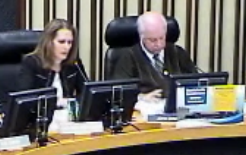 Councillors Meed Ward and Taylor seemed to see eye to eye on the sale of the waterfront property – but Taylor did vote for the sale of the land. Meed Ward knew hers was going to be the only dissenting vote but she appeared to want to be on the record when she added: “I know the residents in this city, I have heard from people in every ward, and they want us to put public waterfront access at the top of our agenda.”
“They want us to preserve what we have.”
“I know” she continued. ”that if it is not this council there will be a council that will realize the vision”.
“The residents will not change” said Meed Ward, implying that councils come and go. However in Burlington Council members stick around for a long time.
Councillors Taylor and Dennison have warmed their seats for more than 20 years.
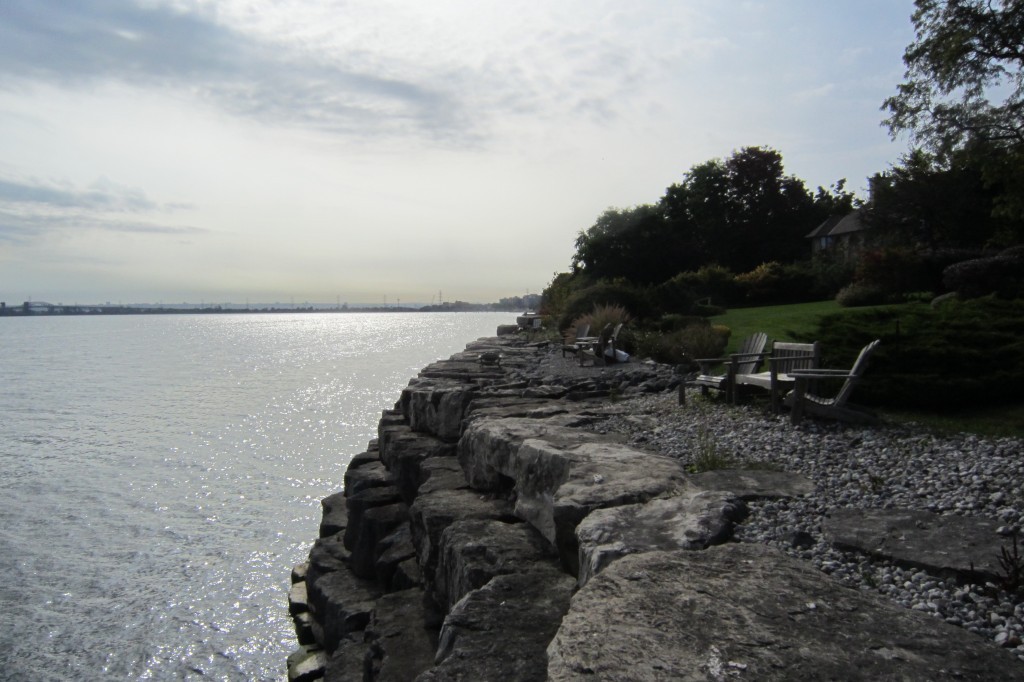 Councillor Meed Ward called the site “magnificent” and “spectacular” It will soon become totally private. The resident’s wants access to the spectacular, magnificent waterfront said Meed Ward. This is no the last chapter. I know the community will see this through. It may take 50 years, it may take 100 but the public will eventually have the trail they want.
When the other members of Council spoke they chose to be defensive. Councillor Dennison said he agreed with a lot of what Meed Ward had to say but as Councillors we have to “pick our battles”.
“This particular piece of land does not fit the vision” Dennison added that he didn’t like being painted as against a waterfront trail – he just didn’t think a piece of land the city already owned was part of the vision; something he didn’t enlarge upon.
Sharman said he too supports a public waterfront but there are circumstances that have not been portrayed correctly.
 The two windows on the Lake on the East and the West will be accessible by the public. The parkette in the middle will become private property. Don’t expect the Windows to be all that inviting. One council member wanted any amenities to be “minimal” There has been a “massive deception” that is the critical issue that has to be recognized by the community.
The problem is the “circumstances” Councillor Sharman refers to were never made available to the public.
Sharman is sticking to his guns and closed his comments saying: “We’re doing the right thing”.
Councillor Lancaster appeared to be reading from the same script Sharman had. “At the end of the day” she said” “given the legal opinion and the complexities of this particular piece of property it didn’t make sense” to keep it.
That wasn’t the view of the Staff report which recommended leasing the property. Senior staff probably did not see the report Swartz had prepared and made available privately to some members of Council.
Mayor Goldring said “this issue has been around for 20 years – this council has addressed the issue and made a decision. “We are showing leadership”.
 Standing up and being counted as they vote to sell city owned waterfront property. The one thing that came across as this sorry episode came to an end is that there were legal opinions and privately commissioned reports that were not made available to the public.
Somehow, the transparency this council speaks about often did not apply to these documents.
Councillor Craven made no comment.
Councillor Taylor said he felt the issues had been personalized and he wanted council to get on with other matters.
Links:
Part 1 How the decision got made
Part 2 The Scobie delegation – it made no difference.
Part 3 The Swartz situation
Part 4 Meed ward position

 By Pepper Parr By Pepper Parr
January 6, 2015
BURLINGTON, ON
A four part feature on the city’s decision to sell small parcels of land that it owns that fronts on to Lake Ontario between Market and St. Paul Street. Part 3: The Swartz situation.
Frederick Michael Swartz will, in the near future, take possession of the property that runs from the edge of the back yard of his Lakeshore property to the edge of the retaining wall on Lake Ontario.
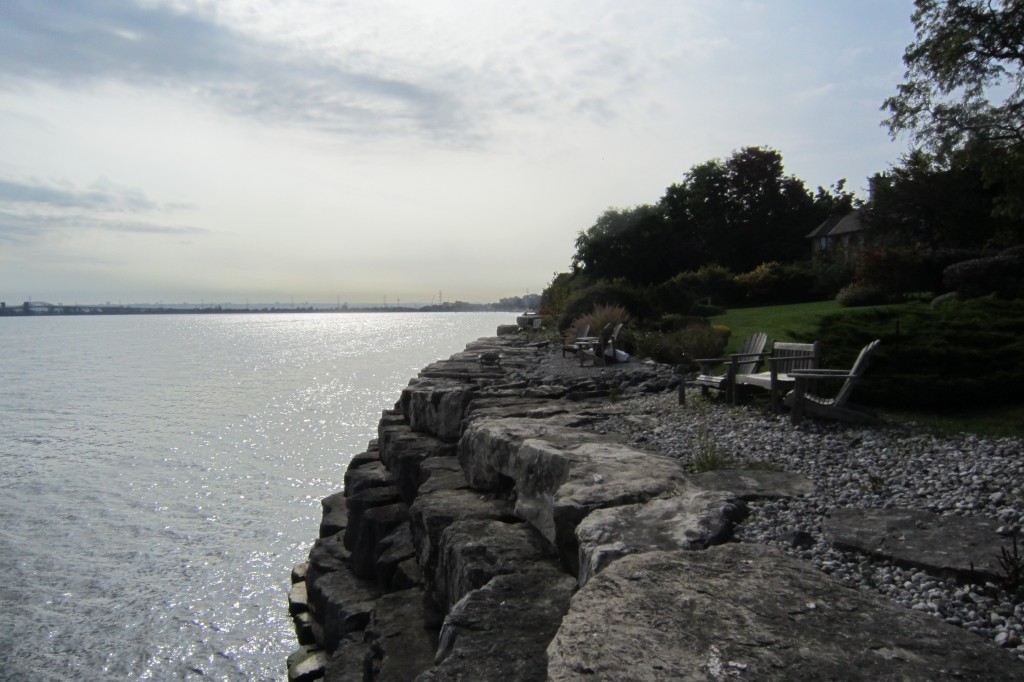 One dreams about setting like this. It is now private property. He already has a magnificent site – when he takes possession of what is now city and provincially owned property, they will have exclusive access and all the privacy one could ask for.
The public does not yet know what Swartz paid for the property – that will be disclosed when the deal is complete. Swartz is actually buying land from the Ontario Ministry of Natural Resources and the city of Burlington.
The purchase of the land creates a property that has immense potential. When it next changes hands – and property always changes hands – it will see an impressive increase in value.
The property was purchased in September of 2007 for $1,850,000
Getting the small parcels of land was a battle but Fredrick Michael is a tough nut used to getting what he wants. He is described as a very successful retired banker who now spends his time on community projects and is heavily involved in Habitat for Humanity.
 Janice Connell after delegating to city council i committee – She thinks she just might have nailed it! Swartz and his wife Janice Connell did a fine job of delegating at city hall; she did the schmoozing that was needed with members of council. She got into what was pretty close to a spitting match with Councillor Meed Ward but she was just one vote which the Swartz’s didn’t need.
 Six of the seven voted for the sale of city owned water front property on a recoded vote. Councillor Marianne Meed Ward was the dissenter. Several of the Councillors couldn’t get their hands up for that YES vote at city Council on December 18, 2014 fast enough.
Some people have a bit of a beef with Swartz and his wife. They did nothing wrong – they saw an opportunity and they went after it and they knew how to do the lobbying and the report writing.
They hired a highly regarded real estate professional who did the research and provided Swartz with a solid case for the city to sell the property. It was an opinion that appears to have been made available to members of Council – not to all of them – but the public is never going to see the document.
While Council appears to have relied heavily on the report – they haven’t said a word about it. Had they done so they would have had to make it public and the understanding in place when the information was made available was that it was never to be made public. Swartz bought and paid for the report.
Janice Connell was the spokesperson for the family. This is a spunky lady – she made her point each time she delegated and did her best to take on Councillor Meed Ward directly.
Connell told city council that selling the property was the best decision the city could make. Many people do not share that view. It was certainly the best decision for the Swartz household and it will be great if at some point that family deeds it to the city – but that isn’t going to happen any time soon.
The villains in this disaster was a city council that let themselves be swayed by some pretty persuasive arguments.
And in doing so they forget about what the city is about; they also managed to overlook more than a dozen sound policies that were in place. Add to that they chose not to go with the pretty solid Staff Recommendation.
This is a city council that is swayed by people with a lot of money. Developers come pretty close to walking all over this council.
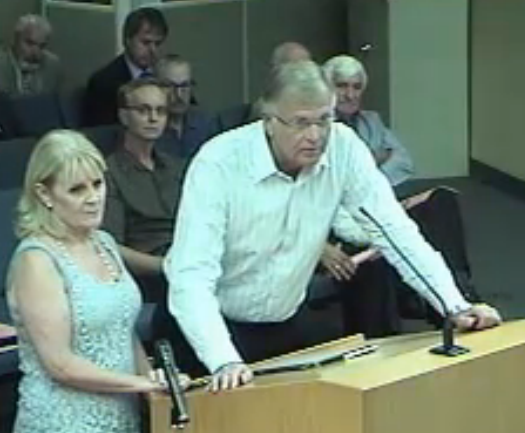 Mike Swartz, delivering a very hard message to city council. We don’t want to sue but we will if we have to. They have already retained legal counsel. This council fears litigation; when it looked like the city was going to balk at a possible sale Frederick Michael slipped up to the podium in the Council chamber and let them know he was quite prepared to take his case to the Courts. Almost every member of Council tucked their tails between their rear legs and moved on to another part of the agenda.
Frederick Michael did what anyone else in the same position would have done. When he saw an opportunity to purchase the property he put together his case, did the lobbying that was needed and had his wife serve as the spokesperson. She did a very good job.
As spokesperson Janice Connell decided to reach a little further than her grasp could accommodate and attempted to tangle with Councillor Mead Ward who chaired the Standing Committee that was hearing the delegations.
Rule 1 when delegating: stick to the subject; rule 1a – don’t try to beat up the chair.
Meed Ward made it evident that she could handle Connell and while some sparks flew – no harm was done. Frederick Michael and his wife had won what thy came for – they didn’t need a scalp in their belt as well.
It was a significant win for Swartz who represented the other two property owners whose homes abutted the strip of land that was going to be and should have become public park land.
 Mayor Goldring and Councillor Meed Ward were on different sides of the decision to sell water front property. History will tell which of the two was right. The long term goal of a continuous waterfront trail has been set back as much as a century. Mayor Goldring took the position that there was “no long term possibility to connect the park at Burloak with Spencer Smith Park”. “If we did” he added “I would look at this much differently.”
It sounded like the Mayor was saying creating a complete Waterfront Trail was like trying to put a man on the moon. We’ve already done that Your Worship.
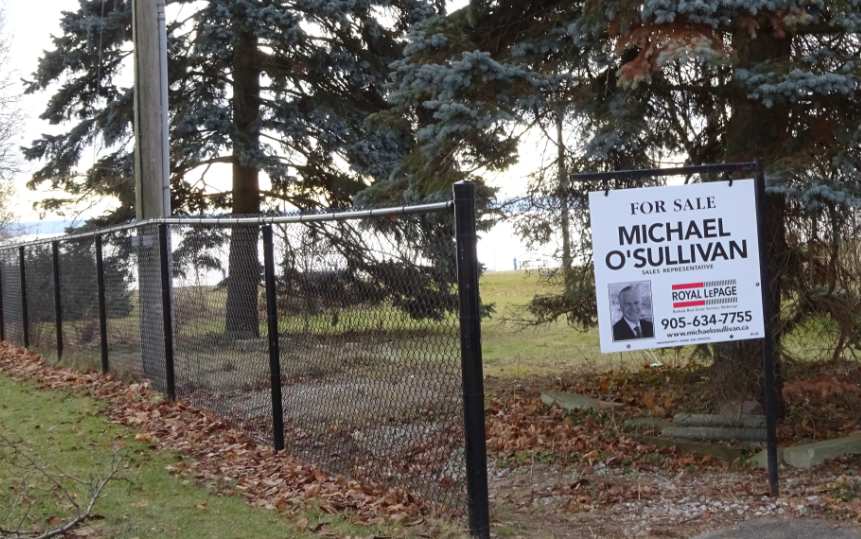 A lot three properties to the east of the lots that are adding waterfront land to the homes is on the market. Council seemed oblivious to this news. Except for Meed Ward every member of council saw the position they had taken as one of real leadership. While council was agreeing to the wording of the bylaw that would permit the sale to take place a piece of property three properties to the east of the Market and St. Paul properties came on the market. Meed Ward said she had had discussions with the agent and the property owner and there appeared to at least be some room for discussion.
Council needed both a vision and the will to see the potential – they had neither.
There is a scene in the movie On the Waterfront that has Marlon Brando sitting in the back of a cab saying to his agent: “I could have been a contender” after throwing a fight in the ring.
This newly elected Council threw the fight and ensured that Burlington was not going to be a contender and have something most cities on a body of water yearn for, strive for – a place for its citizens to enjoy nature.
The stretch of waterfront land is now going to be enjoyed exclusively by Frederick Michael and his two neighbours. Good on him.
Links:
Part 1 How the decision got made
Part 2 The Scobie delegation – it made no difference.
Part 3 The Swartz situation
Part 4 Meed ward position – to follow later in the week.


By Gary Scobie
January 5, 2015
BURLINGTON, ON
A four part feature on the city’s decision to sell small parcels of land that it owns that fronts on to Lake Ontario between Market and St. Paul Street. Part 2: The Scobie delegation.
I come here today with some hope in my heart. We have a new Council in session, and though the names and faces remain the same, we on the Waterfront Committee are hoping that perhaps, in the spirit of renewal of your vows to do what is best for all citizens of Burlington, you rethink this issue of selling public waterfront owned by all of us to a few chosen citizens.
 Gary Scobie delegating on behalf of the Burlington Waterfront Committee to stop the sale of waterfront property owned by the city. We have a grand vision; it’s actually a hundred year vision, not unlike the vision of the Waterfront Trust and their Ontario Waterfront Trail. Their vision is to link the public to their waterfront and to establish a contiguous walking trail along the shores of the St. Lawrence and Lake Ontario first and next Lake Erie, followed by all the Great Lakes on our border. Theirs is certainly a long term vision.
Our vision in Burlington is to have a contiguous walking trail along our Lake Ontario and Burlington Bay shorelines. Each Window to the Lake is like a pearl; each trail between them is like a strand, so the end result would be like a strand of pearls along our shoreline. It could be magnificent.
This vision may seem unrealistic, yet big visions have been hatched and developed in our area before, with great success over time. My wife and I belong to the Bruce Trail Conservancy. The Conservancy is celebrating its 50th anniversary of inception in 2014. In 1964, a small group of dedicated visionaries imagined a natural walking path along the entire length of the Niagara Escarpment, from Queenston to Tobermory.
An “Optimum Route” was mapped out and volunteers began to work with local governments, landowners, conservation authorities and other naturalist groups to create this path on a protected from development basis. Their vision was certainly long term and audacious. Fifty years on, half of the 880 kilometer trail is secure in Conservancy hands or in the hands of government agencies.
The other 50% is either trail on private lands with landowner permission or routes on public roads where permission or ownership has not yet been attained. Will it take another 50 years to secure the whole trail? Perhaps, and maybe even longer, but the vision is still intact and progress toward the goal continues every single year.
This is what can happen when there is leadership and there is a grand vision. The same thing can happen over the next hundred years if we in Burlington dedicate ourselves to this mission.
 Gary Scobie thought this could become one of the strands in the string of waterfront pearls that would become a complete Burlington Waterfront Trail. We thought last year that we had a chance to put a strand in place between the Market and St. Paul Street Windows to the Lake. It didn’t even seem bold, since the land was already in public hands. A staff recommendation, with advice from the City’s Legal Department, recommended that the lands be retained for a future parkette and Waterfront Trail between the Windows.
This future trail would be similar, yet different to the Waterfront Trail at Sioux Lookout Park between Guelph Line and Walkers Line. It would have a good length, about two-thirds of that at Sioux Lookout, but would be quieter and more natural because it would be away from Lakeshore Road noise and activity, buffered by the houses between the trail and the main road. And instead of having two static “no exit” Windows at St. Paul and Market, the public would get a through trail whether coming from east or west.
An ideal place to walk or cycle through or take a break on a bench beside the trail and the shore while moving along the Waterfront Trail. Again, similar but different than the experience at Sioux Lookout.
But something unexpected happened. For reasons still not adequately explained to the public, the “old” Council discussed the issue in a closed session, then voted to sell the land, against staff and legal recommendations to retain it. Before our first strand had been completed, we saw a knife slice it and dash our hopes for the future.
 Gary Scobie, second from the left, was part of the city’s Waterfront Advisory Committee and went on to be part of the Burlington Waterfront Committee. Councillor Marianne Meed Ward is on the far right. Despite overwhelming numbers of delegates appearing here on October 13, 2013 to ask you to retain this shoreline land versus delegates asking to sell; despite overwhelming emails received urging retention versus sale, the “old” Council reversed the proportions and overwhelmingly voted 6 to 1 to sell the land, without any evidence given whatsoever that the broader public endorsed this view and the denial it imposed, possibly forever, of a public shoreline pathway there.
But a “new” Council may yet listen to our voices and the voices of neighboring residents and citizens who can see and share this vision of a start to the string of pearls that parkettes between Windows can be. We ask that you do not approve the sale of these lands to private interests and that you dedicate yourselves to preserving, not selling public waterfront. We ask that you look to ways to make use of other Water St. shore lands to form future strands. We ask that you look at ways that new development and re-development along our shores can create Waterfront Trail sections for the public. We ask that you consider what Burlington could be a long way down the road and that you buy into this long term vision, not put a dagger in its heart at its very inception.
Yesterday I received up updated advisory email from Marlaine Koehler, Executive Director of the Waterfront Regeneration Trust, amending her Jan 20, 2014 memo to Council. In it she states their position might not have been clear then, in light of newer information.
The Waterfront Regeneration Trust’s position today is:
1. Public lands on the Great Lakes waterfront should stay in the public realm and accommodate the Waterfront Trail. Burlington was one of the founders of the Trail.
2. If in fact, the land sale can be revisited, The Waterfront Regeneration Trust urges the City to do so, and retain ownership/interest in the lands so that they may eventually be incorporated into Burlington’s Great Lakes waterfront system.
So today you will decide to send a clear message that Burlington either supports the Waterfront Trail or that it doesn’t.
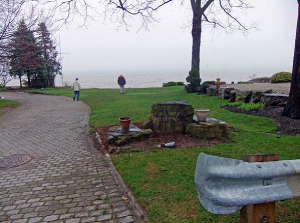 No city signage on this piece of city owned property. Plans are in place to make a proper Window on the Lake at this location. Burlington – Best Mid-Size City. Burlington – Family Friendly. Burlington – Urban and Rural. Burlington – Lake and Escarpment. In Burlington, we celebrate and boast of our waterfront. A decision now to sell means we will be adding a new moniker – Burlington – Public Waterfront For Sale.
Please stop these sales and approve your original staff recommendation to retain the land.
Gary Scobie has been around election issues for a long time. He was raised in Dundas, stayed there until graduating from McMaster, and considers Dundas his home town. He began working in Burlington in 1979 and has resided here since 1980. He has been involved in waterfront issues for the past six years and is a member of the Burlington Waterfront Committee.
Scobie was the lone delegator on the matter of the recommendation to stop up and close Water St. land parcels and sell the property to the three abutting property owners.
Links:
Part 1 How the decision to sell the waterfront property got made.

 By Pepper Parr By Pepper Parr
January 5, 2014
BURLINGTON, ON
A four part feature on the city’s decision to sell small parcels of land that it owns that fronts on to Lake Ontario between Market and St. Paul Street. Part 1: The decision – how it got made.
It all began with a report that was the response to a Staff Direction put forward by ward 2 Councillor Marianne Meed Ward back in 2012.
Direct the Manager of Realty Services to report back to the Budget and Corporate Services Committee regarding the portion of Water Street located between St. Paul Street and Market Street providing the background and history and options available to the city. (Councillor Meed Ward) (SD-30-12)
 Members of the original city sanctioned Waterfront Access Protection Advisory Committee did the early work on just what the city had in the way of windows to the Lake and just how accessible they were. Council liaison to the Committee Marianne Meed Ward is on the right. The Waterfront Access Protection Advisory Committee (WAPA) had done some extensive work on the state of the twelve Windows to the Lake. WAPA members covered the city from one end to other and looked at every “window” location and commented. That mess at Market and St. Paul Street was included in their report.
Councillor Meed Ward did not expect her Staff Direction to result in the sale of the land.
Staff did a thorough job and came back with what appeared at the time to be a reasonable compromise that protected the property the city owned and gave residents whose homes abutted the waterfront property long term protection and the privacy they desired.
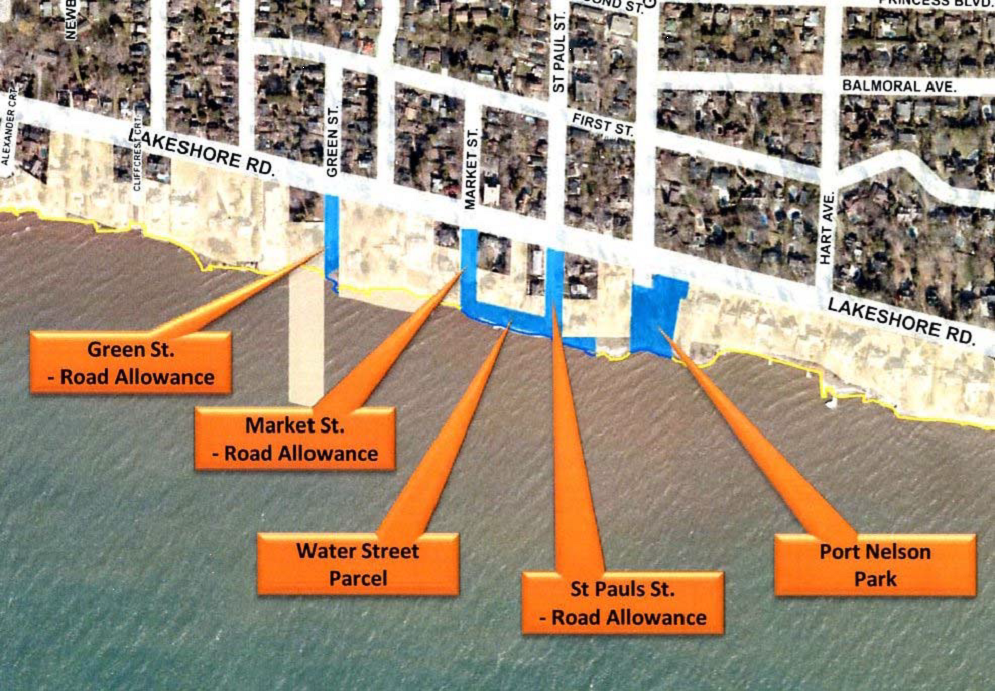 The since sunset Waterfront Access and Protection Advisory Committee produced a report with good graphics that set out what existed in the way of city owned land that could be opened up more effectively to the public. The staff report came back with three options:
1. Create a City Parkette – connecting the St. Paul Street and Market Street road allowances
2. Develop Windows-to-the-Lake at St. Paul Street and Market Street and retain ownership with an exclusive lease to the abutting land owners until required for public use
3. Develop Windows-to-the-Lake and dispose of Water Street parcel.
and recommended option 2, leasing the land.
Council voted 6-1 for option 3 – to dispose of the land.
In a arriving at the decision to sell the land the city had a confidential report from the city solicitor. The public never got to see that document nor did the public get to hear any of the debate. All the discussion was done in a closes session of Council. The Burlington Waterfront Committee was so upset at that process they lodged an official complaint. We will report on how that went.
 The view to the east from the edge of the retaining wall. This property has riparian rights that could have extended the pathway to the east a little further. That decision opened up an opportunity for those people whose property abutted the properties, that were owned by both the city and the Ontario Ministry of Natural Resources, to make an offer to purchase land.
There is a lot of murky legal history surrounding the way the retaining wall was built. When Judges make decisions they become public information. One of the problems with the judicial system is that it wasn’t designed for the average man. Without case numbers and the ability to follow a judicial trail it is very difficult to follow the threads of a case. Just because a decision is made by a Judge does not mean it was a great decision; that is why we have appeal courts.
 The City solicitor lets the public down with her tendency to keep information to herself; lawyers tend to behave that way. The practice is – say nothing unless you have to. Our legal system is an adversarial one. The public tends to get lost or forgotten in that kind of a process. The spirit of community engagement does not yet get much space in the office of the city solicitor and this Council seems to like it that way. The City solicitor lets the public down with her tendency to keep information to herself; lawyers tend to behave that way. The practice is – say nothing unless you have to. Our legal system is an adversarial one. The public tends to get lost or forgotten in that kind of a process. The spirit of community engagement does not yet get much space in the office of the city solicitor and this Council seems to like it that way.
There is nothing preventing this city council from taking a position that every legal document is made public and ensuring that it is posted on the city web site.
The Staff Report with the recommendation that the property be leased was supported by Provincial Policy, Regional Policy, City Official Plan and Parks and Recreation policy.
The Regional Official Plan designates all of Burlington’s shoreline as “Regional Natural Heritage System”. Regional Official Plan Amendment (ROPA 38) Policy 125 (10) states; “To protect and enhance the Halton waterfront as a major resource that is part of the Provincially significant Lake Ontario and Burlington Bay shoreline.”
Policy 118(6) states: “Encourage the development of trails within the Regional Natural Heritage system”
Policy 118(14) states: “Encourage the Local Municipalities to: a) Acquire public open space on tableland adjacent to watercourses and along the waterfront within the Urban Area; b) Identify and designate along or near the waterfront of Lake Ontario and Burlington Bay, a continuous waterfront trail, making use of public road allowances in locations where public waterfront properties are not available”
Burlington Official Plan calls for acquisition of land to create new or add to existing Windows-to-the-Lake/Bay shall be encouraged by City Council, as a means to increase public access to the waterfront.
Corporate Policy – Parks & Recreation – Waterfront Trail (September 27, 1993) is provided as Appendix B – Waterfront Trail specific excerpts pertaining to this report are provided below:
 The acquisition of land adjacent to existing Windows-to-the-Lake and Windows-to-the-Bay, as well as opportunities to create new Windows-to-the-Lake or Windows-to-the-Bay as they become available, will be considered by City Council, where practical and feasible, to increase public access to the waterfront. The acquisition of land adjacent to existing Windows-to-the-Lake and Windows-to-the-Bay, as well as opportunities to create new Windows-to-the-Lake or Windows-to-the-Bay as they become available, will be considered by City Council, where practical and feasible, to increase public access to the waterfront.
It goes on to say: “A continuous Waterfront Trail will be implemented through development and/or redevelopment along Lake Ontario and Burlington Bay where there is sufficient land between that water and a public or private road. This trail may be composed of two components: a shoreline trail immediately abutting the Lake or Bay, and a near shoreline trail located in the general vicinity of the Lake or Bay.
And adds “The Waterfront Trails will be connected to existing waterfront public open spaces and, where appropriate, other points of interest in the general vicinity of the waterfront.
More: “The City will develop specific guidelines and a marketing program for the Waterfront Trail that will include, but may not be limited to, landscaping, fencing, lighting, signage, parking, construction materials and trail furniture, in consultation with the public, Region of Halton, the Halton Conservation Authority, and other public agencies.
And more yet: “Waterfront trail policies were introduced in the 1997 Official Plan. Since that time limited development along the waterfront has occurred. Waterfront Trail policy development objectives have resulted in the city expanding the waterfront trail and public ownership including:
Easterbrook townhouse development near the Royal Botanical Gardens (RBG), is one where the city required public waterfront access through the Official Plan Amendment (OPA) and rezoning application resulting in Spring Garden Trail.
 This is where the the trail will end – it begins at the canal further west. This may well be as far as it goes for the next century. The Bridgewater project, that 22 story condo to be built on the edge of the lake, saw the city swap land so that a trail could be built between the water and the development – it is in place now. This is the eastern part of a stretch that goes west to the canal at the Hamilton border.
The Staff report that recommended leasing the land also set out the categories of public space that could be created when considering options including, Parkettes and Windows- to-the-Lake.
“Parkettes are described in the Parks and Recreation and Cultural Assets Master Plan as: Small landscaped venues intended to contribute to an area’s urban design, provide passive/rest areas and lower level park amenities; can be accessed by walking and cycling. They would have features that may include landscaped areas, rest areas, public art, monuments and related features.
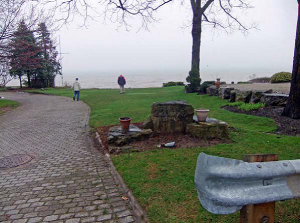 You wouldn’t know it – but this is public property and anyone can walk out to the end and look over the lake. City will now put signage indicating that the land is public. Great views. “Parkettes typically have Seating area(s), walkway connections to the community, bike racks and refuse containers. Some include creative playground structures, tree and shrub plantings; signage and fencing for demarcation of public and private property.
“Windows-to-the-Lake are described as small public areas located on city road allowances next to Lake Ontario or Burlington Bay; established to increase public access to the waterfront. They tend to have bollards or railings to keep vehicles on the road allowance and signage to identify as Windows-to-the-Lake.
The Staff recommendation was to preserve the land for future public use which meant: A) Purchase of the MNR portions of the waterfront between St. Paul’s Street and Market Street road allowances; retaining the ownership of the water lots; Creation of Windows-to-the-Lake on the existing St Paul Street and Market Street road allowances, Entering into lease agreements with the adjacent home owners for exclusive use of the public land between St. Paul Street and Market Street until which time the city decided to develop a waterfront Parkette.
Pros: Supported by the Waterfront Trail Policy, land remains in public ownership, retention of larger land base to create a future waterfront Parkette, retention of option to connect Market Street to St. Paul’s Street. Would provide formalized public access creating an opportunity for residents and waterfront trail users to enjoy the waterfront. Risks associated with shoreline protection is maintained by the adjacent land owners through agreement.
Costs and Liability issues with shoreline protection constructed by the adjacent residents in 1989 as per confidential Legal report L-20-13 can be accommodated in the lease agreement
Limits the establishment of further encroachments in structures or landscape development
Cons: Restricted public access to publicly owned properties along the waterfront is inconsistent with the Waterfront Trail Policy, Uncertainty for adjacent landowners on timing to develop future Parkette, Residential properties to the east and west of the road allowances limit the opportunity to continue the waterfront access beyond this site. Limited benefit as a continuous connection for the Waterfront Trail, existing properties contain encroachments that would require removal or integration into a future park plan and extension of the waterfront access beyond the site would require further land purchases or through development processes
Option Three to dispose of Water Street Parcel and develop Windows-to-the-Lake instead involved: Selling the city and MNR water lots between St Paul Street and Market Street to the adjacent land owners, creation of Windows-to-the-Lake on the existing St. Paul Street and Market Street road allowances
Pros: Access to waterfront would be formalized through two formally developed
Windows-to-the-Lake, proceeds from sale of property could finance a portion of the Windows to-the- Lake implementation, clear demarcation of land ownership with the formalization of the Windows-to- the-Lake, risks associated with the shoreline protection becomes the responsibility of the purchaser, resolves any potential legal issues as per confidential Legal report L-20-13 (which the public never got to see. Issues of encroachments would be resolved, development of Windows-to-the-Lake is a clear message to residents of the opportunity to enjoy the waterfront
Cons: Could be seen as inconsistent with Official Plan and Waterfront Trail Policy on public access and development objectives, no opportunity to establish a Parkette and waterfront trail with the sale of these public lands
Retaining the land for future consideration allows the city to plan for the purchase of land, capital costs for Parkette and Windows-to-the-Lake development and costs associated with repaying the adjacent land owners with the depreciated value of the shoreline protection works implemented in approximately 1989.
The following provides the capital and current budget impact for each of the options provided for consideration based on 2014 development costs.
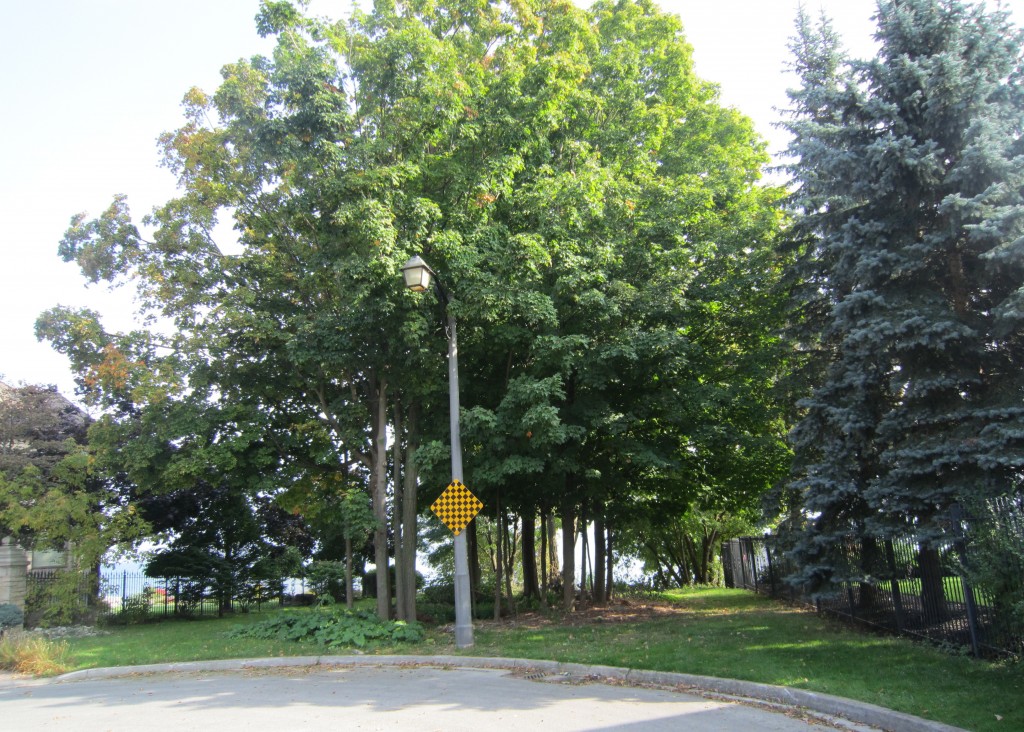 This road allowance will be tidied up and turned into a window on the Lake. A bench will be put in along with a sign telling the public they can use the space. Councillor Dennison did his best to ensure that signage and benches would be minimal. Option One– Create a Parkette on Water Street Parcel
Capital expense of $182,000 plus $7500 per year to maintain the land.
Land costs and shoreline protection were set out in the confidential document.
Option two: Preserve for Future use
Capital cost of $80,000, which includes costs to construct and maintain Windows-to-the-Lake; $3500 per year to maintain the Windows on the Lake. Land costs were hidden in that confidential report.
Option three – Dispose of the land:
Capital cost $80,000 and $3500 per year to maintain the Windows on the lake.
Revenues from the sale of the land are identified in L-20-13; that’s the confidential report council got to read and debate – so they apparently know what the selling price is.
The Gazette has information that it cannot yet corroborate that the deal has already be closed.
Estimated cost for Parkette and Windows-to-the-Lake development, which is the leasing option, is $182,000. This does not include the land costs or costs to repay adjacent landowners for the constructed shoreline protection identified in confidential Legal report L-20-13.
Given that staff did not previously identify the development of this property for parkland, the Finance Department propose the use of Parkland Dedication Reserve Fund (PDRF) toward the development of the Parkette and Windows-to-the-Lake. The PDRF has an uncommitted balance as of June 30, 2013 of $9.8 million. Additionally, this park is not identified in the city’s current development charges study.
 Taking ownership of this property will enhance the value of the three homes that abut it. The public will learn what was paid for the land – later. The Staff report also said: “Upon receiving direction from council on an approved option, staff will develop and undertake a community engagement process which outlines the purpose, outcomes and participation goals of any engagement opportunity. Outcomes of the public engagement process will be reported back to council with concept plans for the Windows-to-the-Lake and Parkette development.
There has been absolutely no public consultation other than petitions from the opposing sides – each have radically opposing conclusions.
There is one more surprise – the public will not know how much the buyers pay for the property until the deal is closed.
Don’t you just love the way your council manages your affairs?
Links:
Part 2 The Scobie delegation – it made no difference.
Part 3 The Swartz situation – to follow later in the week.
Part 4 Meed ward position – to follow later in the week.

 By Pepper Parr By Pepper Parr
January 4, 2015
BURLINGTON, ON.
The Burlington Economic Development Corporation (BEDC) Strategic Plan was introduced to a Council Stranding Committee recently. There was a blessing from Council and a sigh of relief as well as the hope that the desperately needed leadership was finally in place. Newly minted Executive Director Frank McKeown left them feeling confident.
After far too many years of expensive consultant’s reports the hope is that there is a board that means business and will do business
The updated Strategic Plan incorporates the principles of the BEDC which they believe will deliver the outcomes the City desires and in some cases redefine achievable results envisioned. There is now a dose of reality as well as a reality check.
 The BEDC has had a difficult four years. Under the direction of the former Executive Director, it was never able to get beyond commissioning report after report. Significant Burlington companies chose to leave the city – at least one was taken from us right under our noses. The BEDC has had a difficult four years. Under the direction of the former Executive Director, it was never able to get beyond commissioning report after report. Significant Burlington companies chose to leave the city – at least one was taken from us right under our noses.
The Board decided that it had had enough and dismissed the Executive Director in 2013 – on All Hallow’s Eve – and began taking a look at what was needed. A high powered group of executives was brought in as advisors and with all kinds of input from former city manager Jeff Fielding they looked as if there wasn’t a business they didn’t want to get into.
It is amazing what sensible, proven executives will think of when they feel they have their hands on the public purse and not all that much in the way of genuine oversight. A one point they were going to create close to half a dozen corporations to get into property acquisition and development.
 Former city manager Jeff Fielding had all kinds of ideas on what could be done with the Economic Development Corporation. When Fielding bought a one way ticket to Calgary some of the high flying ideas were given a reality check and a new board was installed; they appointed Frank McKeown, formerly Mayor Goldring’s chief of staff.
The BEDC Strategic Plan was developed to address key economic community needs:
a) Investment and assessment growth;
b) Growing local employment opportunities and
c) Accessible Industrial Commercial Institutional (ICI).
The BEDC then adopted a number of key strategies to pull this off:
Develop an Economic Vision for Burlington that will fit into the City’s Strategic Plan. The plan will have very specific goals and tactics that are well researched and can be executed.
Develop and maintain critical economic data, reports and policy; this will require an upgrade in capacity but will form a long-term basis for better insight and decision-making.
In his report to Council McKeown said: “It is vital that Burlington increase the investment at the Industrial, Commercial Institutional level – relying on the residential portion of the tax base is a recipe for a financial disaster for the city.
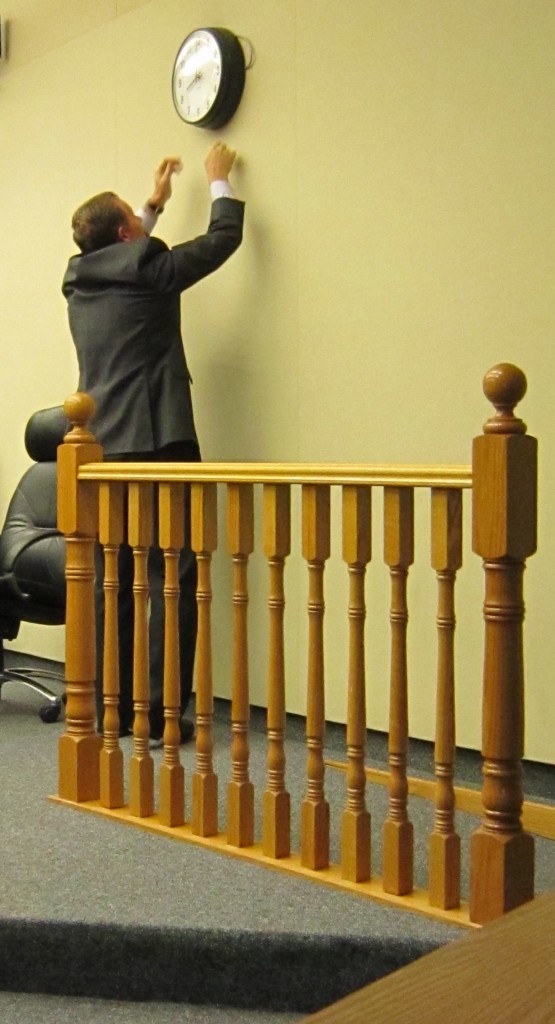 Frank McKeown, while the Mayor’s Chief of Staff, attempts to fix the clock in Council Chambers. He now gets to set the clock for economic development. In an exclusive interview McKeown explained part of his problem. “We don’t have an economic vision”. He added that part of the problem in creating an economic vision is the need to tie that to the vision the city has for itself – and at the moment the best Burlington can do is point to the three pillars in the Strategic Plan put together in 2011: Prosperity, Vibrant Neighbourhoods and Good Governance.
What has Burlington got going for itself other than a lake at the bottom and an Escarpment at the top – which is basically geography. The city has talked about eco-tourism and making the cycling opportunities more attractive – but Burlington isn’t France and there is never going to be a Tour du Burlington.
We did have a shot at some major cycling events in 2012 but that one got away when the cost of policing the event just wasn’t feasible financially.
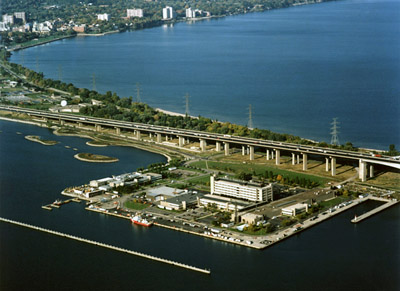 The federal Inland Water operation has been around for years and was thought to be a possible anchor for the creation of an economic cluster. Burlington does have a very significant cluster of corporations involved in the water business – some 60 of them. With the federal Inland Water Centre serving as an anchor there was the hope that something could be developed. Turns out that most of the companies in the water business didn’t want to cooperate all that much for fear they would get to know each other too well and poach specialized talent from one another.
The city does have a nascent pool of engineering talent and significant depth in the 3P field which, combined, gets Burlington corporations involved in some major projects. 3P’s are Public Private Partnerships that bring private funds and expertise to the table to build public infrastructure projects; from the water we drink to the roads we drive on.
Recent reports suggest that these 3P project end up costing the government much more than if the government did all the work themselves. The other side of that argument is that governments tend to go over budget and well beyond the planned delivery date.
 The Joseph Brant Hospital is a 3P project that involves a number of Burlington corporations. The Joseph Brant Hospital re-build is a 3P project that recently announced who the lead contractor is going to be. That team includes local financial expertise.
McKeown is focusing on who the major property owners are in the city. He has a list with nine names and has already met with five of the nine to determine what they have in the way of land holdings and what their long term objectives are. This includes the development, in coordination with land owners and developers, of a 5 year investment profile around potential development and a proactive approach to local development opportunities. He then has to square that with the city Official Plan. It is a challenge.
The BEDC is being restructured around services. We must be able to answer the question – How can BEDC help grow our business? explained McKeown. Services being evaluated include access to senior government funding, accessibility to McMaster research for Small Medium Enterprises (SME’s), export growth support, support for start-ups, and key peer networking opportunities.
These will be largely partner driven. The BEDC will partner with the city to create a surplus land marketing pilot. Burlington doesn`t have all that much surplus land but the pilot will allow the City and BEDC to establish principles around land development opportunities and for BEDC to develop land development/marketing competencies in a low risk focused way. Surplus lands will remain under City ownership in this process until the transaction is completed.
 Frank McKeough, former Chief of Staff to Mayor Rick Goldring asked about how politicians can handle complex issues when voters tend not to be informed. As the Executive Director of economic Development he can now be very proactive at informing the voters. When McKeown was the Mayor`s Chief of Staff his biggest frustration was the rate at which things got done at city hall. McKeown was frequently heard muttering `”there isn`t any speed at city hall”. Culturally, BEDC will re-tool its processes and activities to respond at the Speed of Business to business and opportunities.
In addition, they will be following a partnership strategy to help us achieve the outcomes the community needs. These partnerships will include clear definition and agreement on activities. BEDC will be pursuing a broad range of partnerships expanding on its partnerships with the City and Team Burlington to include partnerships with the Halton Region, HalTech (local Research and Innovation Centre), McMaster University and an expanded partnership with the Burlington Chamber of Commerce. They will also be working to establish ongoing stakeholder engagement with the important actors in the development community and key business sectors.
One of the areas the BEDC has not managed yet to do the job that has to be done is finding a better more relevant and effective way to communicate with the public. The communications team was dissolved and a more fresh approach is being created.
The BEDC is getting out of the networking business and has passed that along to the Chamber of Commerce – they will share the networking opportunities. McKeown tells people that their networking events brought in a lot of money – but they also cost a lot of money to make happen and while staff were immersed in putting on events they weren’t able to get much done in the way of attracting new business to town.
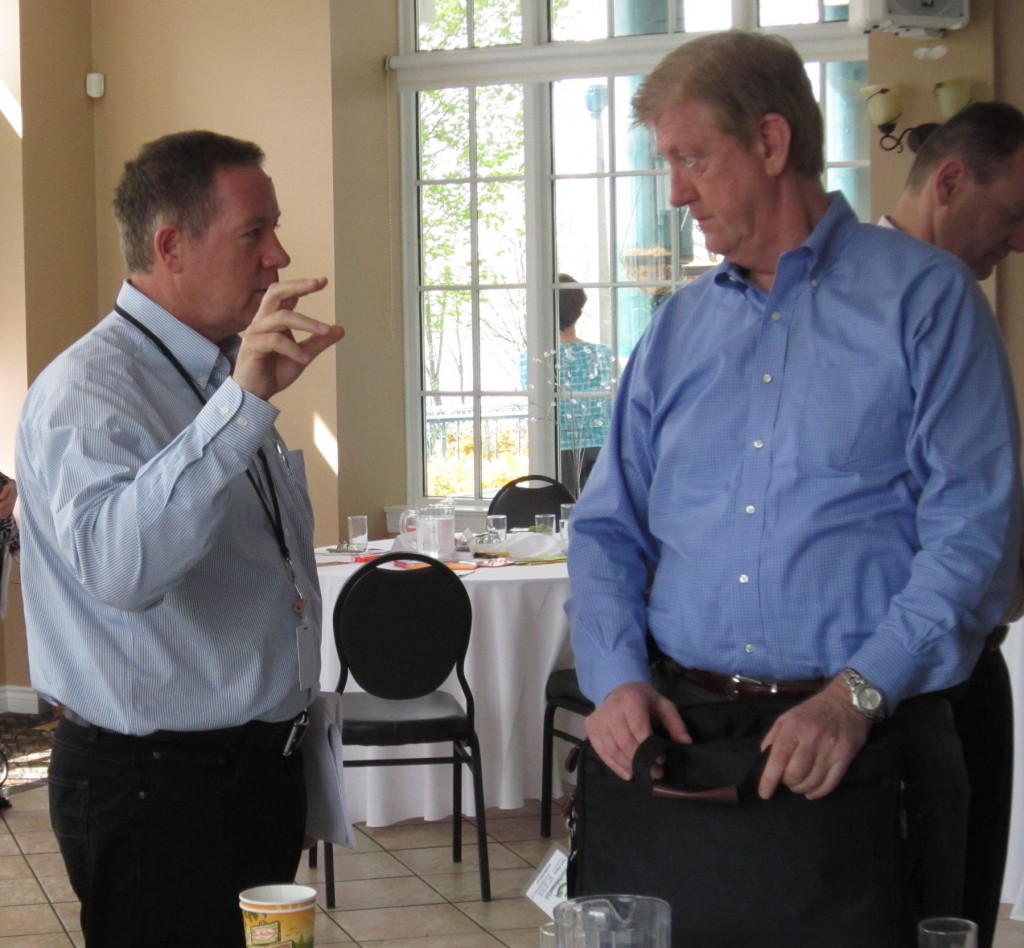 Frank McKeown, then the Mayors Chief of Staff explains a concept to Ward 5 Councillor Paul Sharman. Both are strong believers in the need for solid, verifiable information before decisions are made. McKeown wants to see much better data. Much of the data coming out of the Region is “less than reliable” according to McKeown. The approach he says to measuring results in a number of areas is “not consistent and we end up with data that doesn’t tell us what we need to know”. Putting systems in place to gather the data, validate it and then make decisions based on that data will take time and it will cost – but McKeown knows better than most that without good data you cannot make good decisions.
Many of the areas of focus for BEDC are new or currently unmeasured. The organization has identified how they we will measure performance and will begin immediately to track and report on these identified measurements. Over a short period of time they will have benchmarks established and performance results published.
The BEDC board has decided it will not move forward as a Land Development Corporation.
During his time as city manager Jeff Fielding began the developing of a relationship with the Fraunhofer Institute. They are Europe’s largest application-oriented research organization whose research efforts are geared entirely to people’s needs: health, security, communication, energy and the environment.
Fraunhofer has aligned itself with McMaster University and Burlington wants to become part of that relationship. McMaster currently has a meaningful project with Fraunhofer in life sciences.
 McMaster University’s DeGroote School of Business is seen as a prime resource by the economic development people. The connection is being developed. McKeown explains that McMaster is the number two research and development university in Canada (University of Toronto holds the number one spot). “Part of what we want to do is achieve much better access to these people and the commercialization of some of the research they do. They are a tremendous resource.
For once we have an agency that isn’t pushing its snout into the public trough and asking for more money. The BEDC proposes to operate in 2015 at the existing base budget level. As they evaluate the pilot land marketing activities they will have a revenue measurement which they will use for future evaluation.
When McKeown got into involving the public in economic development his report said: “Earlier discussions regarding BEDC reorganization identified some public engagement requirements. BEDC is not reorganizing the corporation at a level to trigger this requirement. BEDC will be actively engaging stakeholders and the public during their development of the Economic Vision.
Not exactly an invitation for the public to voice an informed opinion is it?
This time around there is a board in place to get a job done; no longer are there a bunch of people who sat at the BEDC board table to protect the interest of the organization they represented. A welcome change.
The ball is now in McKeown’s hands – assuming the Board he reports to acts as a Board and not a group of people with personal agendas. McKeown has a proven track record – he can pull this off if he is given the room and the resources. He is financially prudent and knows what risk is and how to measure it.
The biggest unknown for McKeown is what his former boss is likely to do. City Council has to create a vision for the city that is real and compelling.

 By Pepper Parr By Pepper Parr
January 4, 2015
BURLINGTON, ON.
They are called Character Area studies; exercises where planners and residents meet to talk about what kind of a community they want.
In the past few years Burlington has done two of these: one in the Roseland community where the exercise is still underway and a second at Indian Point where the exercise was wrapped up.
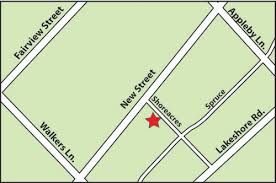 A part of the city that is rich in history Shoreacres may get a serious look at what it is and what it wants to be as part of the Official Plan Review. There is a Business Case in the 2015 budget for a third Character study for the Shoreacres community. Priced at $60,000 this study is part of the Official Plan review and came out of a Staff Direction.
This community has deep history – more so than Roseland. Both communities have been hit by what many refer to as predator developers who purchase older buildings on large lots; demolish the building and apply for a variance to divide the lot and put up two houses.
While many in the community regret the sale of what are seen as prime historical properties for every buyer there is a willing seller.
The Paletta Mansion is within the Shoreacres boundaries. Originally deeded to Laura Secord, who never lived on the property, the magnificent house was saved from destruction when purchased by the city. The Paletta family donated a large sum and had the house and park area named after them.
The Indian Point Character Study was wrapped up when the Planners came to the conclusion that the residents were so badly divided on a direction for the community that nothing could be achieved.
Indian Point has a rich history as well with large lots that cluster around the lake and Indian Creek.
These Character studies give residents of a community the opportunity to decide collectively what they want their community to look like and what they would like to see preserved. The people who live at Indian Point couldn’t arrive at any kind of consensus. The rank greed on the part of several participants during the Indian Point meetings was unsettling. It was difficult to see much in the way of community at those meetings.
 A per-fabricated bridge is installed over Shoreacres Creek. The Roseland character study meetings have been more civilized – close to genteel actually. But it has taken a long time and there isn’t yet a clear sense yet as to where the community wants to go.
What is clear in Roseland is the desire to see fewer demolitions which the majority seem to not want.
However, the ward Councillor has an Ontario Municipal Board hearing coming up in March at which he is appealing a Committee of Adjustment decision to not permit a re-zoning application to sever his Lakeshore Road property.
What Councillor Jack Dennison is doing would appear to be at odds with what the community says it wants – but they re-elected Dennison by a respectable majority.
Burlington is clearly struggling with its character as a city. There is work to be done.

 By Pepper Parr By Pepper Parr
January 3, 2015
BURLINGTON, ON
Understanding developers requires a mind that can see into all kinds of cracks and crevices.
The Gazette got a call from a reader alerting us to trees that were being cut on the property to the east of Emmas Back Porch.
We made some calls – city hall was shut down for the holiday period and it was difficult to get any real information. We visited the site and took some pictures – speculated that the property might be something the ADI Group was looking at for a sales office.
It took a little time to get through to people – here is what we know.
 What was once a gas station is now an empty lot with not a tree left on it. No one, other than the owner, knows what is going to happen next. We will keep you posted. The owner of the property Draco Vranich, who owns the Waterfront Hotel, has the right to cut down trees that are on is property because the city does not have a private tree bylaw.
Because the site is on the lake’s edge it comes under the jurisdiction of the Conservation Authority as well as the city.
Someone cut down a lot of very mature trees and pushed a lot of the brush over the bank and into the lake.
The Gazette was told that that Draco Vranich was planning on putting in a parking lot that would be used by the “trades” who would be working on the Bridgewater a couple of hundred yards to the west.
Bruce Krushelnicki, Director of Planning and Building informed the Gazette that a free standing parking lot would not be permitted on that site without a change in the zoning.
Krushelnicki also noted that some survey work had been done on the site – there were survey markers in the ground.
During a meeting with the Director of Planning “on another matter” he advised the property owner that a parking lot was not permitted on the property.
He added: “There are no permits issued for this site (site plan, site alteration or building permits) and since the site has no buildings on it, no demolition permits have been issued recently.
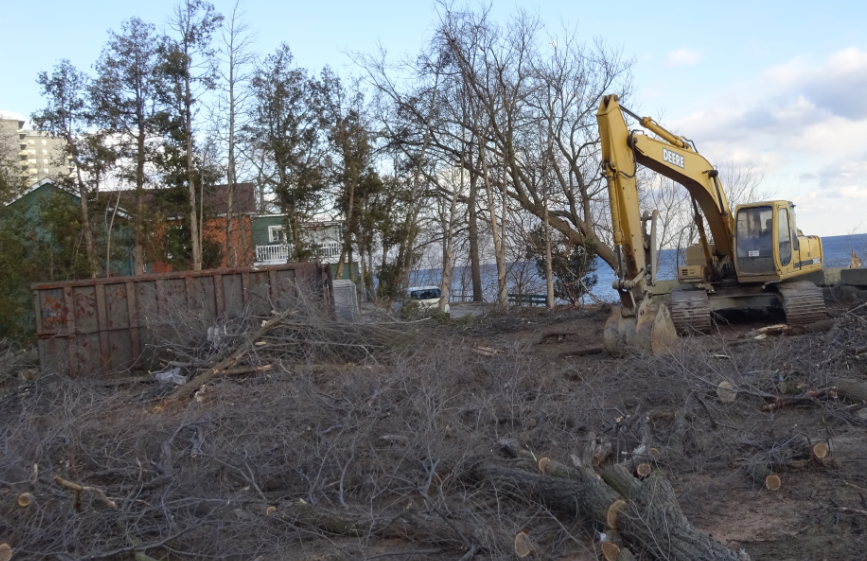 By the time anyone from city hall got to the site most of the big trees were down and the trunks carted away. Could that have been why the work was done during the holidays? Accordingly I observed no excavation, construction or site alteration. It appears – as I reported to you earlier – that the owner in concert with the neighbouring owner, is “cleaning up the site” by removing vegetation and debris. There is no development or building taking place on the site and no applications for development or construction have been received. I did not see any work being done on the slope at the rear although debris had been dumped there historically and may be part of the clean up.”
Krushelnicki continued: “I will have the by-law enforcement people monitor the site to ensure that work proceeds in compliance with the permissions granted, the property standards by-law and property maintenance by-law.”
The owner had alerted us to the work, and asked for our advice. So far he appears to be complying with our advice and acting within his rights.”
Looking into those ‘cracks and crevices’ mentioned earlier we know this:
The site is being “cleaned up”; the property has been recently surveyed. The large concrete blocks that were at the front of the property are now at the lakeside of the property – very close to the top of bank.
The site could, under the existing zoning and Official Plan, take a structure three to five metres deep – and as high as four storey’s.
What bothers the public is the not being told what is going to be done to the properties that edge on the lake. The current city council is prepared to sell lakefront property – when there was no need to do so – which has the public a little spooked. If they will sell part of the community’s heritage there doesn’t appear to be any limit on what they will do.
Ward 2 Councillor Marianne Meed Ward strives to keep her constituents fully informed. She had to play catch up on this one.

 By James Smith By James Smith
January 1, 2014
BURLINGTON, ON.
Enfant Terrible: A term not used much these days, but I like to think of my pal Eric Cunningham as the quintessential Enfant Terrible.
Quick, sharp, partisan, did not suffer fools quietly; who cut through the crap and saw stuff from many angles, but always with a sparkle in his eyes when he’d make a precise evaluation of a situation or an individual. What a shock to know that this force of nature has passed far too soon.
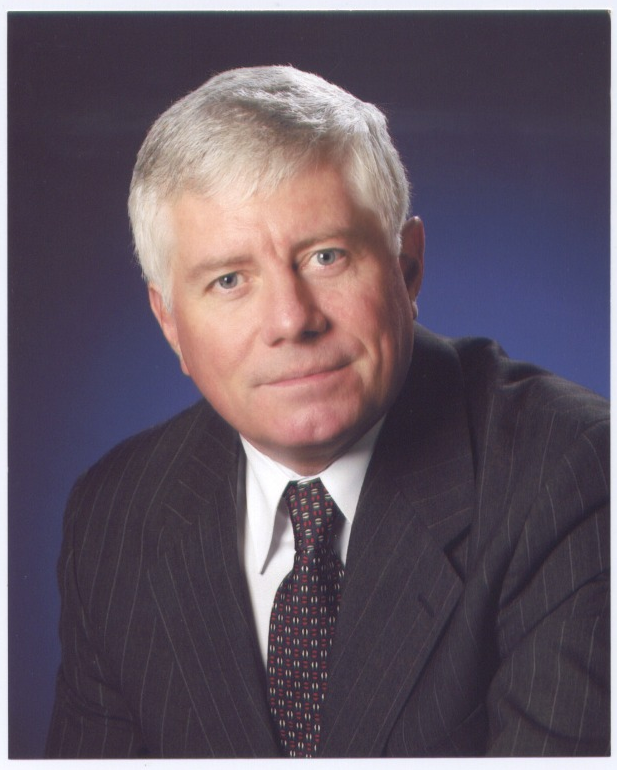 Eric Cunningham – dead at 65. Eric and I have been putting off sitting down for a relaxing conversation over what he called, an Adult Beverage for weeks now. The stuff of day to day life just kept getting in our way, now, sadly at the far too young age of 65, Eric Cunningham has joined that smoky back room eternal.
Damn!
Damn and blast!
I first met Eric in 1987, I was new to Burlington, and a mutual friend in Calgary suggested I look Eric up when I moved here. I did and was at once both put on my heels by the forthrightness of this man and attracted to Eric’s no nonsense attitude.
Eric had resigned from the legislature a couple of years before. When elected as the MPP for Flamborough North Burlington, Eric had been the youngest Member elected to the Ontario’s legislature. I was a young Liberal and was thinking of running for the nomination here in Burlington and Eric had been beaten by our MP, the late Bill Kempling,
I wanted to know if he was thinking of running, and if not, to get some advice from him. We met for said Adult Beverage and Eric listened politely to me. After a few minutes he stopped me and asked: “Do you want to do the job or not”? Direct, to the point! I had learned just who the essential Eric was.
Eric was very good with his time, having understood what it is to put one’s life on hold, put your face in front of the public, only to be rejected.
Eric and I did not travel in the same social circles, but we were happy warriors, who often shared the same sophomoric partisanship and who liked each other’s company and the occasional Adult Beverage. For the most part, we ran into each other when we’d be working on the same side in the many political trenches we’ve found ourselves in over these past many years.
Recently when I was considering running for municipal council, Eric’s evaluation and advice made me a better candidate. The best advice he gave me was to ask some tough questions and to ask “win or lose, will you be at peace with yourself if you don’t run?”.
Eric’s personal life had been through a rough patch lately, but when we spoke last week he was excited to put these troubles behind him and wanted to catch up.
Like so much in life, our plans get made and then fate steps in to unmake them. Burlington is a smaller and different place without my pal Eric, and I shall miss him dearly.
Eric Cunningham is survived by his wife Heather and a daughter.
The funeral will be at Smith’s Funeral Home, details to follow.

 By Pepper Parr By Pepper Parr
January 1, 2015
BURLINGTON, ON.
The Gazette got a call from a reader about some work being done on the lot that is the east of Emma’s Back Porch. Huge concrete blocks were being moved around and every tree on the property had been cut down.
 The property is accessed from Old LAkeshore Road. It was once the location of an gas station. Might that mean there are environmental clean up issues? There were a lot of stumps left – they were apparently going to be coming out later.
The work was being done at a time when city hall was closed – convenient?
Our first guess was that the ADI Group saw an opportunity to put a sales office on that piece of land; I would be in a direct line of site from where they plan to build a 28 story condominium.
 There was some speculation that the property next to Emma’s Back Porch might be the site for a possible sales office for the ADI Group that has an application in for both an Official Plan Amendment and a significant upgrade to the zoning for the site. The circle indicates where the proposed ADI Group project is to be built. ADI managed to get a zoning variance to set up their sales office on Brant Street but they are limited to three years at that location – and they are going to need more than three years to sell out a project that doesn’t yet have a name.
A comment from a city hall staffer said: “The property belongs to Mr. Vranich, who also owns the Waterfront Hotel. We met with him last week on another matter and he mentioned to us that he would be “cleaning up this site” and referenced tree removal from private property.
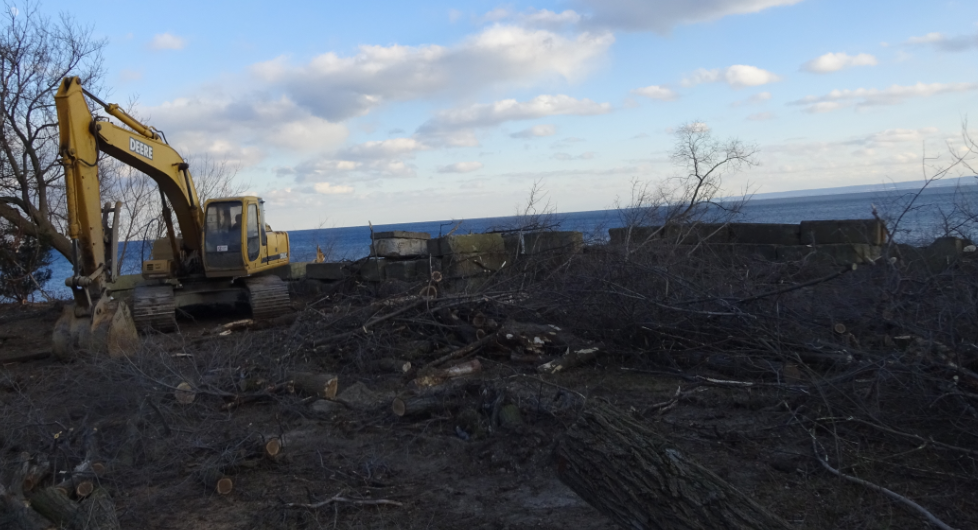 The Conservation Authority is going to want to have a conversation with the owner of the property – and perhaps explain what “top of bank” actually means. “He also explained that he and Mr. Jackman owner of the Emma’s property plan to clear the brush and trees along their shared property line. We advised him that he can clear trees from his private property, but should speak to the conservation Authority about trees near the stable top of bank. We also advised that he cannot remove trees from City property without a permit.”
“He does not have a building permit so he should not be excavating and has no site plan approval or (to my knowledge) site alteration permit, so he should not be altering the grades on the site. I will visit the site and see what he is doing, and will provide you with an update.”
The “top of bank” issue – which falls into Conservation Authority will fall into one of those “I didn’t know that” or “the workers did more than they should have”.
All kinds of tree trunks and brush have been pushed over the top of the bank. It was that need to set back any structure a specific number of metres from the top of the bank – a definition every planners knows about – that made any plans Tim Horton’s had for any construction on the site.
It was also the issue that basically ended what IKEA wanted to do on that North Service Road site. Tuck Creek ran down the east side of that property and that limited what IKEA could do.
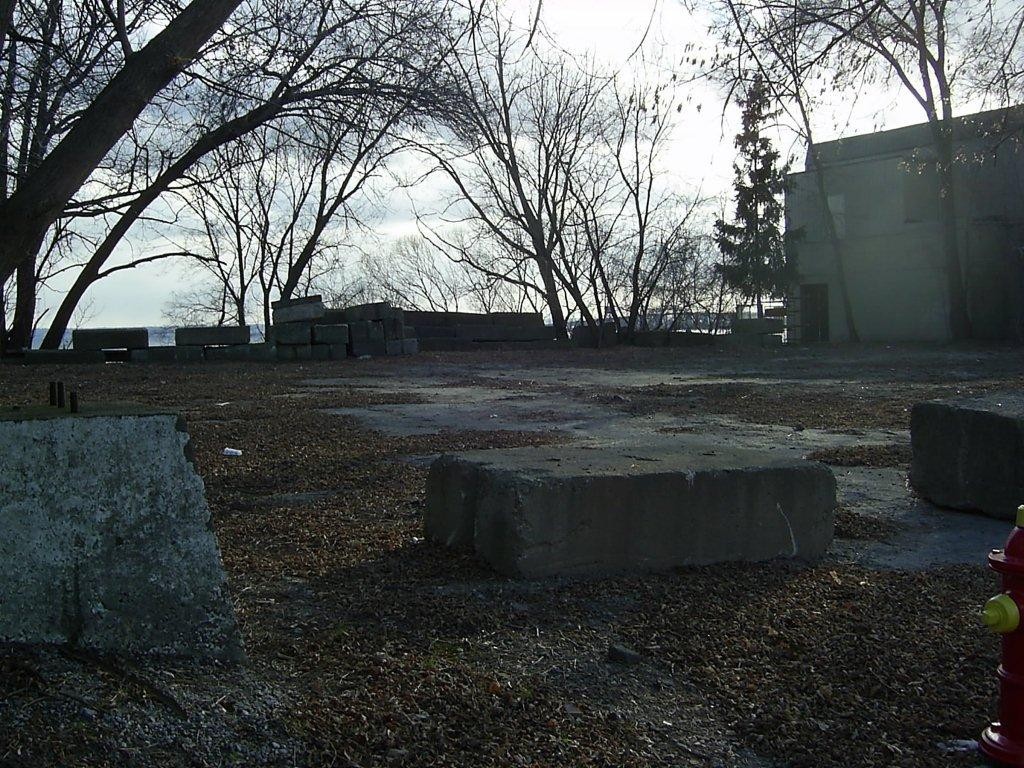 This is what the site looked like a few years ago – before the pier was completed. The Gazette got out to the site and took some pictures and talked to a couple of sources and were told that the owners of the property had cleared the site and planned to create a parking lot – which they hoped to be able to rent out to the trades that will be working on the Bridgewater project.
Plausible – the concern is – why was all this being done at a time when there was no one at city hall that could slip on over to the site and check out what was being done.
When the Conservation Authority people get back to their desks on Monday – they will have a lot of questions to ask.
Ward 2 Councillor Marianne Meed Ward said she wasn’t aware of any development plans for the property – those things are always run by the ward Councillor
This is a small story worth following.

 By Staff By Staff
December 30, 2014
BURLINGTON, ON
The Globe and Mail editorial of December 27, 2014 sums up the year and the ongoing performance of our Prime Minister. We saw that editorial as significant enough to re-print it.
 Columnist Ray Rivers on sabbatical enjoying a beach in New Zealand – that is really green grass in the background. Our regular political columnist, Ray Rivers, is currently on a short two month sabbatical and will be writing once every two weeks. He wanted to comment on this editorial. His remarks are shown in a different typeface,
From the Globe and Mail: I can’t even get my friends to like me,” Stephen Harper said this year. A joke, obviously, delivered during a moving eulogy for his close friend and political ally Jim Flaherty in April. But more than a joke, too.
The Prime Minister has never been the cuddliest of humans; he was once photographed shaking his young son’s hand as he dropped him off at school.
It is a mistake for us to believe Canadian’s falling support for Mr. Harper is about his personality. He is an introvert, which is not his fault. His trailing Trudeau in the polls has more to do with most Canadians feeling we are going in the wrong direction and could be doing better. It is more about his policies (than his personality) which are divisive – pitting the west against the east, a cynical foreign policy based on ethnocentric values, and stale economic policies which are serving to widen the wealth gap among Canadians.
That formality can be a strength in crises. After the two attacks on Canadian soldiers in October, Mr. Harper’s natural gravitas was reassuring to Canadians. It even gave his party a noticeable bump in the polls in November.
But the ring of truth in Mr. Harper’s quip reverberates less because of his solemn demeanour than it does because of the unyielding way he plays political hardball. The Prime Minister is not someone you want as a friend, politically-speaking, and much less someone you’d want as an enemy.
Not a friend and not an enemy – what does that leave us with? There are times when his demeanour makes us admire him, as in his response post the Parliament Hill fiasco. But then his lack of breadth of vision leaves us to wonder if he gets it at all. Somehow It doesn’t sink into his think skull that the shooting is the kind of thing that should be expected when you abolish the long gun registry, or jump into a war. Oh and Mr. tough guy hid in a closet during the incident, mimicking his own ‘Bush-like’ 911 courage.
He fights ruthlessly and without remorse. He dumps inconvenient allies, sows division with abandon, treats Parliament with contempt and works 24/7 to control what Canadians know and hear about him, usually through the hearty application of muzzles and misdirection.
I’d agree that he governs in an autocratic manner and is control-freak possessed, banning public contact with the public service, for example. Sometimes I wonder if he has not been understudying Mr. Putin. And his lack of loyalty to those who did his dirty work does not wear well on him. I’d add Duffy, Wright, Wallin to that list.
That’s not news, and nor is it all that peculiar to one politician. But, in 2014, the Prime Minister’s bloody-mindedness began to feel like a liability. With him as leader, the party has consistently trailed Justin Trudeau’s kinder, gentler Liberals in the polls in spite of the country’s relatively stable economy. If the Conservatives under Mr. Harper lose the general election next fall, this year may be remembered as the one when Canadians, including members of the Conservative Party, decided their leader’s ruthlessness was no longer worth the cost.
If Harper loses it will be because Canadians want a fresh face and a fresh approach to governing – out with the old divisiveness and back to some core Canadian ‘liberal democratic values’ such as fairness (e.g. how the PM mis-treats Ontario and Quebec).
One of the more telling moments of 2014 came the day after an armed man had stormed Parliament and been killed within metres of a room where Mr. Harper was meeting with his caucus. The morning was marked by sadness and courage as MPs returned to the House of Commons in a display of solidarity; the Prime Minister spoke movingly about the symbolic importance of Parliament, and he even gamely walked across the floor to hug the Leader of the Opposition, Tom Mulcair, and Mr. Trudeau.
And then, several hours later, the Harper government dumped another monstrous omnibus bill onto the Commons, an act knowingly contemptuous of the Parliament the Prime Minister had just praised as the lodestar of Canadian democracy.
Omnibus bills are designed to defeat Parliament’s oversight role. The thick bills allow majority governments to push through major policy changes with little debate by combining multiple unrelated issues into one over-sized turkey. They are an abuse of process; the Conservatives have tabled four since 2010, and the most recent was the second largest.
Mr. Harper was also a repeat offender in 2014 with regard to the dispatching of belligerent junior ministers and hapless parliamentary secretaries to defend problematic legislation in the House or derail Question Period. Pierre Poilievre’s smarmy sales job of the flawed Fair Elections Act and his subsequent climb-down in April were the low points of the year. Or would have been, had not Paul Calandra reduced himself to tears in September after a demeaning display of question-dodging on Mr. Harper’s behalf.
That is a good point, that while previous governments have employed omnibus bills to move milestone, ‘sea change’ policies, Harper appears to use the approach more cynically, to hide stuff. Former justice minister Trudeau used omnibus legislation to make Canada a world leader in social policy under the Pearson government – but it was consistent and transparent.
Both incidents embarrassed some Conservatives as much as they outraged opposition MPs.
This was also the year a former Conservative MP, Dean Del Mastro, was convicted of overspending his campaign limit and trying to cover it up, and a former party staffer, Michael Sona, was convicted in the robo-call scandal. Mr. Harper has distanced himself from both men and their actions, of course, as he did with his former chief of staff, Nigel Wright, who somehow believed it was appropriate to pay off the ineligible expenses of a Conservative senator in 2013. No one would dare say that the Prime Minister endorses unethical activities, but there are people in his party who think that anything goes.
And why wouldn’t they? Mr. Harper showed in 2014 that he will play with his elbows out even in the most inappropriate situation. That brings us to Beverly McLachlin, the respected Chief Justice of the Supreme Court whose integrity the Prime Minister deliberately impugned in an absurd and indefensible fashion. He raised a doubt about whether Ms. McLachlin had interfered with the appointment of a new judge, and was then exposed for being completely and knowingly wrong. His grievous misjudgment demonstrated once and for all that there is no Canadian institution he considers sacred if it stands in his way.
There is no excuse for Mr. Harper’s attempt to embarrass the senior justice of the country – in the end he only embarrassed himself. If he so lacks respect for our fundamental institutions – why should anyone respect him or his?
Other consequences of Mr. Harper’s antipathy to Parliament and to Canadian institutions in 2014 included but were not limited to two crime bills that were sent to the Senate containing serious errors, the use of taxpayer dollars on government advertising that happens to align with Conservative election promises, and a new prostitution law that is likely to fail a Charter challenge, and which police forces across the country have little intention of enforcing, thanks to the government’s refusal to listen to contrary opinions while the bill was in that former house of debate we know as Parliament.
It is remarkable that having seen the existing prostitution law thrown out by the courts as dangerous to the security of sex workers, his justice minister brings in a replacement which is even worse. A clear case of ideology trumping competence.
Ask Mr. Harper how it’s going after almost nine years in office and he – along with every single member of his party – will robotically respond that his government is continuing to fight for hard-working Canadian families and lowering their taxes. It’s a spiel that talks past his government’s many flaws. Mr. Harper is responsible for those flaws, which are mirror images of his own, and gets the credit for his party’s successes. Those include an economy that is not great but better than most, shrinking deficits, a real attempt to reform immigration and native education, tax cuts targeted at core constituencies and the effort to help defeat Islamic State in Iraq.
Not a bad record. The question in 2015 will be, Is it worth it? Or could someone else, inside or outside the party, achieve results on the same scale while respecting Parliament and setting a higher ethical standard?
No its not a bad record, except for all the deficiencies the G&M notes. Mr. Harper set out as PM to transform Canada, to make it a nation that more closely reflects his own values, some of which we agree with. And to some extent he has been successful in shaping attitudes and developing a following. How many followers we will only know after the next election, when we put to the real test whether his lagging poll numbers mean anything at all.
 Ray Rivers writes weekly on both federal and provincial politics, applying his more than 25 years as a federal bureaucrat to his thinking. Rivers was a candidate for provincial office in Burlington where he ran against Cam Jackson in 1995, the year Mike Harris and the Common Sense Revolution swept the province. Ray Rivers writes weekly on both federal and provincial politics, applying his more than 25 years as a federal bureaucrat to his thinking. Rivers was a candidate for provincial office in Burlington where he ran against Cam Jackson in 1995, the year Mike Harris and the Common Sense Revolution swept the province.

 By Pepper Parr By Pepper Parr
December 30, 2014
BURLINGTON, ON
The city is taking a different approach to the way they present their budget to the public and a significantly different approach to how staff work with the funds they are given to use.
In an effort to show tax payers where the money is going and the value gotten from the spending the city is now setting up budgets based on the service delivered rather than on just the department that that does the spending.
 This approach has introduced a significantly different business process management and brings forward a phrase you are going to hear a lot of from your council member: Results Based Accountability – the city wants you to know that staff will be accountable for the results they deliver. This approach has introduced a significantly different business process management and brings forward a phrase you are going to hear a lot of from your council member: Results Based Accountability – the city wants you to know that staff will be accountable for the results they deliver.
Not quite sure how that phrase would be applied to the pier. Several council members expressed concern and surprise over how many people in their wards had not ever been to the pier. Yet we spent more than twice the original price of $6 million – and I’ve yet to hear any Council member even mention the word accountability let along accept any responsibility for the thing – which the public appears not to care all that much about.
The city has released a draft budget that will call for a tax increase of 3.55% in 2015 – a little higher than inflation isn’t it?
Included in that budget are nine business cases for new, or improved or upgraded services. Each business case sets out the argument for the expenditure.
One of the nine business cases is about transit – a service expansion, an upgraded Community Connection will cost $337,000, add three Full time employees (FTE’s) and tack on one quarter of one percent to the tax levy.
This service is designed to connect the places where seniors live to the places seniors want to travel to. The Seniors’ Centre would be the hub for this service.
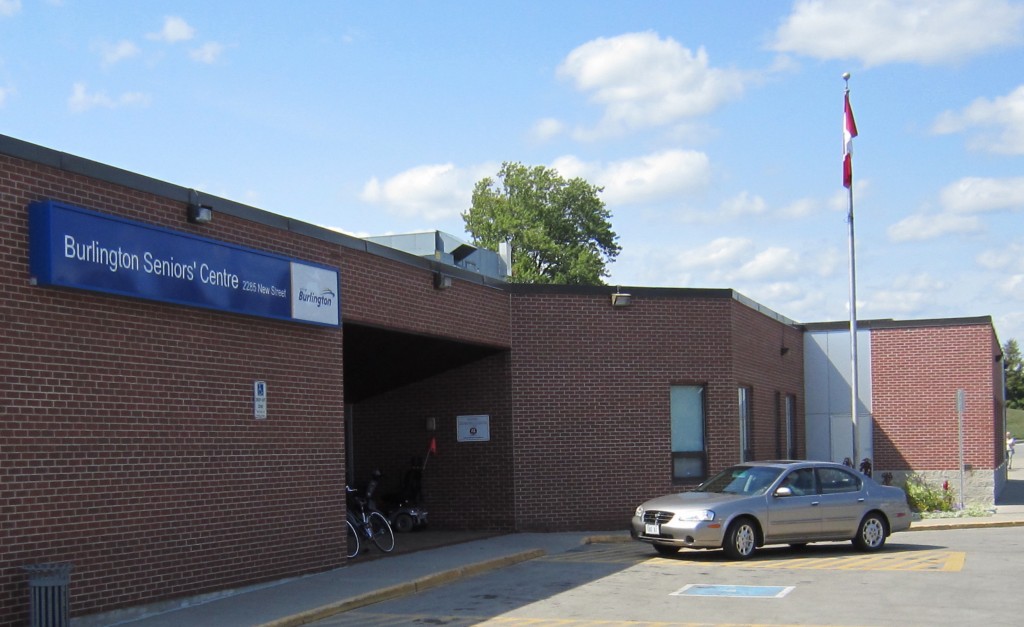 There is nothing fancy about the place. It’s simple, serves the purpose with a bus stop almost outside the door and plenty of parking. The site will become a bit of a mobility hub for the Community Connection the city proposes to upgrade. There is a Community Connection service that runs just two days a week – the proposal is to make this a Monday to Friday service running from 10am to 3 pm with additional links added to the service.
The Business Plan approach requires that the potential benefits and risks be spelled out and that what the metric for success will be. Smaller buses will mean lower fuel costs (lower gas prices aren’t going to hurt either) – the risk at this level is defined as low.
The Business Plan approach requires staff to explain “How Success will be measured”. Here they set the bar so low that they can’t possibly fail. Transit staff talk in terms of an additional 8 boarding’s each hour on the route. The service, if approved, will run for five hours each day –and they call success a total of 40 boarding’s during the week. That seems like an almost incredibly low number. It gets taken up to 14 boardings an hour in 2016.
Included in the nine new business cases is an $84,000 expenditure for 3D Visualization software – which the city should have bought five years ago. It’s a minor expense but the business case doesn’t tell the full story. There doesn’t appear to be any allocation for staff training nor is there any mention of ongoing upgrades to the software – and with software there are always upgrades.
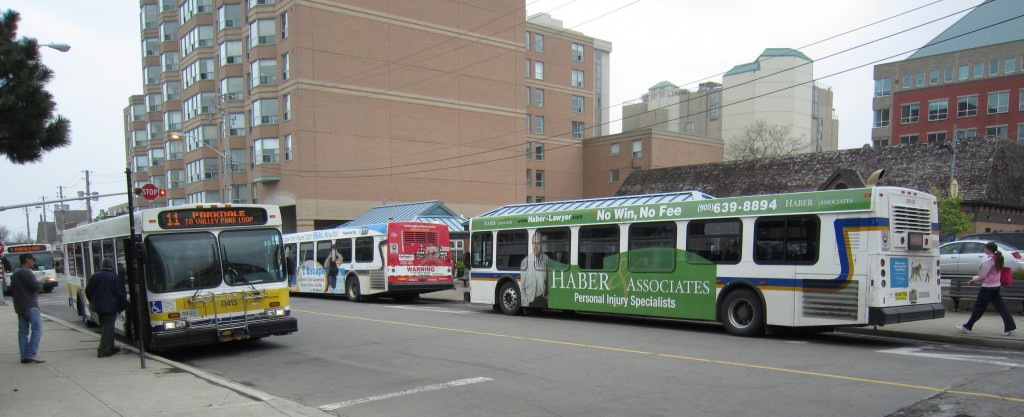 The terminal on John Street where many of the bus service transfers are made is to be made one of the mobility hubs in the city. Still a lot of thinking to be done on how the parking lot gets integrated into the plan. The benefit to the city is they will have a tool that will allow them to create images of the growth of the community. “Building on existing models” the business case made adds that “the downtown will be completed first with other mobility hub areas and intensification corridors to follow”. Mobility hubs are points in the city where different transportation modes come together: the GO stations at Aldershot, Burlington and Appleby Line are the prime identified bubs at the moment with the John street terminal added. There are many that believe there should be an additional hub somewhere near the top of Appleby Line.
 Six properties were assembled in a part of the city that is to some degree isolated – they’ve basically nothing in the way of parks – and crossing the railway tracks is one way this community gets its daily exercise.  Those six properties in the Queensway shown above were assembled, houses demolished and 54 units built. would 3D modelling have let the public know how massive the change was going to be? The 3D models will be used for public engagement, council meetings and visioning exercises. “One of the central elements of the project will be the ability to build the model by requiring builders and developers to submit images of proposed and completed development projects for import to the model.
 An example of 3D rendering. The software used to create the image allows the image to be seen at different angles and elevations. Creatively used it can be a very effective tool. The Capital Works department says “success will be measured by” Customer satisfaction but it isn’t clear just who the customer is. The developers are not going to like the additional expense. They might want access to the model – will the city give it to them?
Heck – the Gazette would like access to that model.
The other two success criteria are “Model Utilization” and the “% of Complaint submissions”. So they have thought of the complaints that will come in. Interesting.
Each business case is required to set out the potential risks and benefits and what the probabilities of each actually are. The benefit/risk probability for the project is high if the project proves to provide an effective tool to assist Council and the public to visualize alternate development proposals.
Not implementing the service is given a medium probability due to the “lack of community support and understanding of intensification”.
 And that is what this $84,000 expenditure is really all about – showing the public what intensification will look like before it gets shoved down their throats. And that is what this $84,000 expenditure is really all about – showing the public what intensification will look like before it gets shoved down their throats.

 By Staff By Staff
December 29, 2014
BURLINGTON, ON.
Roy Brooke is an avid cyclist who lives in Victoria BC. On a trip to Copenhagen Denmark he experienced physically separated bikes and cars with a dedicated cycle tracks.
Brooke tells his story: “Visitors to Copenhagen tend to notice that it is tough to take a photograph without a cyclist or bicycle in it. Cyclists seem to be everywhere, and statistics bear out the impression — 55 per cent of Copenhagers’ use bicycles each day and 41 per cent of people arrive to work or school by bike in the Danish capital.
 In Copenhagen cycling is not limited. any any one demographic “On a visit to Denmark I started to notice who was actually doing the cycling as much as their sheer numbers — old, middle-aged and young people, families with children, women in high heels, people doing chores, people just getting around; every possible segment of society seemed to travel by bike.
“As a parent, what surprised me were the many mothers and fathers in the downtown core with children on their bikes.
“At home in Victoria, I bike on quiet residential streets with my four-year old on the back in his carrier. However, I never venture downtown with him on my bike. In my judgment as a parent, neither the core of our city or the roads that lead to it are safe enough for me to travel by bicycle with my son.
“Yet in Copenhagen, a much larger and more bustling city than Victoria, families ventured into the busy core at all hours with children.
“I rented a three-speed cruiser at my hotel and set forth to find out why. After a few hours biking around Copenhagen, I had several clear impressions. Foremost, during the entire time I biked around town, I never once felt like I was running a gauntlet of death between parked cars on one side and speeding traffic on the other. Almost every route physically separated bikes and cars with a dedicated cycle track.
“In some areas, this was a bike lane on raised pavement. In others, simply but ingeniously, parked cars rather than people were the ones in the road nearest the traffic. This let bikers and pedestrians use the calm, safe space between parked cars and buildings.
 Lanes created for bicycles where they don’t put riders in harms way and pedestrians have the sidewalks to themselves. In Copenhagen it isn’t a “them” and “us” – cars and bikes each have their place.  Traffic management includes instructions for cyclists. “In places without physical barriers between cyclists and car traffic, thick lines painted on the pavement and wide cycle tracks kept cars at a distance, and all intersections were marked to prioritize cyclists.
“In a word, I felt safe.
“I also didn’t need to think much to bike. It was clear where I had to go because cycle routes were clearly delineated. It was clear when I had to go or stop because there were usually stoplights just for bicycles. And, it was clear where I could park or rent bicycles: just about anywhere.
“In short, things were designed not only for motorists but cyclists also.
“My overall impression is that Copenhagen’s physical separation of bike and car routes and having fully integrated design takes the “us versus them” out of cycling. I never felt irritated by motorists because I never came near them. I assume that I never bothered motorists, for the same reason. Pedestrians, motorists and cyclists thrived side by side because the urban system was built with everyone in mind.
“Above all, I understood why parents took their children into Copenhagen’s core on bikes. If Victoria had similarly modern cycling infrastructure, I would do the same here.
“Many other cities — Barcelona, Paris, Dublin for example — have made similarly large and fast leaps. Separated bike lanes, bike-share systems and lowered speed limits were common denominators in their success.”
 Burlington has recently marked lanes to alert car drivers to merging bicycle traffic. Is the time right for Burlington to make a similar leap? A start has been made. We have the chevron markers and there are now several bike lanes clearly marked with green paint alerting drivers to the merging of bicycle tragic,
During the recent municipal elections very little was heard from the cyclist lobby and as close to nothing from any of the candidates. Mayor Goldring seems to have assumed that he has learned a lesson after his flip flop on bicycle lanes along Lakeshore Road.
Burlington could join the ranks of leading, livable cities, not through a dialogue that is about cars versus bikes, but one based on the actual evidence: that proper, modern biking (and pedestrian) infrastructure makes life better for everyone.
New Street is scheduled to have some major infrastructure work done in the next few years. There was a proposal that dedicated bike lanes be part of that infrastructure upgrade – it wasn’t going to be cheap. The argument was to add the dedicated lanes while an upgrade was being done.
That item will come up during the budget debates in February.

 By Pepper Parr By Pepper Parr
December 29, 2014
BURLINGTON, ON.
There are people in the Burlington Community Foundation offices plowing through piles of paperwork during the holiday as the 310 applications for funding under the ODRAP program are reviewed.
The Foundation was given the task of managing the claims process and raising hundreds of thousands of dollars locally to qualify for “two for one” matching funds from the province.
 Claims Committee member Nancy Swietek, Dan Lawrie Insurance listens to a resident whose home was flooded Monday of last week the claims committee, made up of Nancy Swietek, Dan Lawrie Insurance, Rick Burgess, a local lawyer, Mark Preston of Preston Insurance Services and Bruce Russell of Wardell Insurance, went through 22 applications and sent a couple back to the insurance adjuster hired by the Foundation, to give the applications a professional review.
The committee spent two hours clearing 22 claims. Using that as an average, the 310 claims are going to eat up an additional 28 hours of their time – and these people are all volunteers – they don’t get as much as a dime for their efforts; they probably don’t even get mileage.
Funds for those approved should work their way through the cheque requisition process and be in the hands of the applicants very close to the 15th of January.
Those who were late filing their applications will not see any funds until sometime in March. What surprised many, stunned would be a better word, was the more than 100 claims that came in the two days before the deadline.
The Claims committee is handing out funds that were raised by the community and matching funds that given to them by the province – they have a responsibility to ensure that those monies are distributed within the ODRAP guidelines – which, in the minds of many are a little on the stringent side.
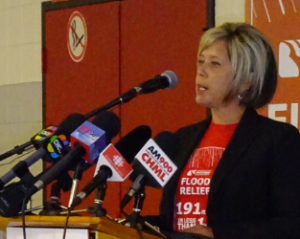 There wasn’t a microphone or a telephone Burlington Community Foundation president Collen Mulholland would get her hands on as she drove the organization that raised very close to $1 million for flood relief victims – she then made sure the province made good on the two-for-one matching grant. While there is no formal process for appealing the finical support given, Collen Mulholland did say that the Claims Committee will listen to anyone who has a concern about what they were given or if their application was denied.
The ODRAP rules are strict. Funds are available to people who were uninsured or under-insured; if the applicant does not meet that criteria there claim will not get processed.
The Burlington Community Foundation hired an independent insurance adjuster who goes over the claim and ensures that the numbers and other data given are correct, fair and reasonable.
 Keven Reimer the insurance adjuster working for the Claims Committee talking to resident at a public meeting explaining the ODRAP program Keven Reimer, the insurance adjuster, made it clear at a public meeting that the objective was to help people get back on their feet. A furnace that was damaged by the flood will get replaced – that Persian rug that was in front of the 60 inch HD TV set – is probably not going to be replaced. You will get funding for a carpet and a decent sized TV set – but the new Persian rug is something you will have to save up for.
The drive to help people in Burlington who were very hard hit by the flood damage August 4th is now coming to a close. Burlington raised close to $1 million in less than 100 days – a remarkable feat that in due course will be properly recognized and celebrated.
All the recognition does not go to the politicians – Mayor Goldring made two critical phone calls and showed the kind of leadership his citizens expect of him when he called Colleen Mulholland at the Burlington Community Foundation and asked if they would take on the task of putting together the team that would deal with the provinces ODRAP program and raise funds locally. The Mayor placed a second call to Ron Foxcroft asking him to head up the fund raising drive.
The people who know Foxcroft knew he was going to put the squeeze on them – and squeeze he did. There wasn’t a banker in the city that didn’t get a call; several got more than one phone call.
There were some local retailers that came through big time for their customers and there were large suppliers of the kind of thing thousands of homes in this city bought to repair their homes that were not heard from.
When the final list is published you will see who showed up and who didn’t.
There were people who did some extraordinary work. Recently elected MPP Elanor McMahon jumped into the trenches and made numerous critical phone calls. When the province at first said no to the request from the city that it be seen as a disaster area and was entitled to the matching funding McMahon was one of the people getting back to the Premier and Minister Ted McMeekin.
There were two members of council who now know more about the basements of houses in the eastern
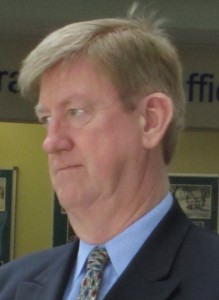 There was hardly a basement in ward 5 that had been flooded that Paul Sharman didn’t look at closely. During the early stages of the fund raising he was one of the more passionate speakers. 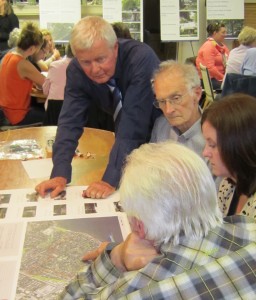 Ward 4 Councillor Jack Dennison spends a lot of time at community events – more so than some other council members. During the early days of the flood his staff had him crawling through more than 1000 basements. Here he works with residents on community planning half of the city. Paul Sharman and Jack Dennison went into hundreds of basements to see first hand how bad the damage was. Both handed out hundreds of forms and handled even more phone calls from worried residents.
Burlington has a to to be proud of – the people and the commercial sector of the city pulled together in many marvelous ways.

 By Staff By Staff
December 29, 2014
BURLINGTON, ON.
Do you remember this time last year?
It was snow, on snow, on snow with dozens of senior staff members out in the field on Christmas Day.
 Millar Road was blocked solid – for several days  That was a live wire when it came down.  This tree actually survived – picture could go on a post card  Hydro crews worked around the clock and late into the night to get power lines back up. In several places new cable had to be strung.  Burlington Hydro CEO Gerry Smallegange explaining to a community meting in Kilbride that work was progressing but it was just going to take time. A little photo feature to remind you what it was like.
Maybe the August 4th flood is Burlington’s bad weather for the year?
Burlington asked the province for some financial relief due to the storm – the claim was for $1.8 million – we haven’t seen that money yet.

 By Pepper Parr By Pepper Parr
December 27, 2014
BURLINGTON, ON
During the 2014 budget deliberations council wasn’t able to find the funding needed to cover the cost of a person to be named as manager of culture for the city.
 The first Culture week for Burlington had a great turnout in Civic Square. Then city manager Jeff Fielding said at the time that while he couldn’t promise anything he would do his very best to find some savings somewhere and crate the position of Manager of Culture for the city.
In 2013 and 2014 the city began to see a different cultural community; the Art Community Collective was formed, the first No Vacancy was put on at the Waterfront to critical acclaim to be followed by a second much larger presentation at the Village Square.
The city held its first Cultural week; the Performing Arts Centre was under stronger management and was making time and space for the smaller community groups – and they weren’t asking for an increase in funding.
The Burlington Art centre underwent a name change and then a change in its leadership.
 Angela Paparizo, now the Manager Art and Culture with Trevor Copp whose delegation brought about a shift in city council’s thinking in 2013 Things on the cultural side of the city were getting more attention and more funding.
General Manager Scott Stewart announced to staff that Angela Paparizo was the successful candidate for the position of Manager of Arts and Culture.
The internal announcement went on to say that “Angela brings more than 10 years of experience in Public Administration, a Master’s Degree in History and Bachelor Degree in Journalism. Angela is continuing her education in Cultural Planning with the University of British Columbia.
“As a Cultural Planner for the City, Angela’s work has been focused on the development of the Cultural Action Plan, Public Art Program, Cultural Mapping, Relationship with Cultural Joint Ventures and Support for cultural community through Community Development and Facility Fee Waiver fund.
“Angela’s experience and passion for arts and culture has helped her successfully develop and deliver Culture Days 2014 in collaboration with artists and cultural organizations.
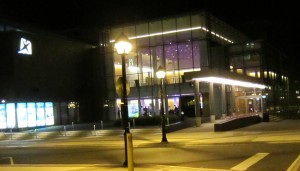 Performing Arts Centre – a key cultural stakeholder – where do they fit into the Cultural Plan and how much input will they have? will they be truly an arm’s length organization? “While working in various management positions in the past, Angela’s extensive experience in project management including proposal writing and budgeting has helped her strategically plan highly creative and impactful arts and culture programs that inspire public involvement and provide value to the community.
“As a Manager of Arts and Culture, she hopes to continue her rewarding work in advancing collaborative, community-based programs and services, developing cultural opportunities in Burlington and enhancing the quality of life.”
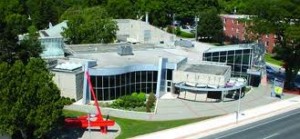 With a new name and a brand that is being developed and some bright people running the show – where will the Art Gallery fit into the Cultural Action Plan. The challenge now is to put energy and financial resources into the job as it has been outlined. It is a significant step for the city. In the past culture has resided within the Parks and Recreation department where the focus was on sports and recreational activities.
With new, and hopefully more focused management, culture and the arts will have a chance. The trick is to ensure that we get beyond “Elvis on Velvet” and that the community understands it will take time to pull all the stakeholders together and get them singing from the same sheet music.
There is a very delicate balancing act to be done; diplomacy is going to be a key element and the prime stakeholders will have to be brought on side. Avoiding turf wars will be a challenge.
How avoiding a lineup of artists with their hands out gets pulled off will be interesting to watch.

|
|
 By Staff
By Staff













 Grano is described as a business performance advisor with two decades of experience with the Ontario government.
Grano is described as a business performance advisor with two decades of experience with the Ontario government.

























 The City solicitor lets the public down with her tendency to keep information to herself; lawyers tend to behave that way. The practice is – say nothing unless you have to. Our legal system is an adversarial one. The public tends to get lost or forgotten in that kind of a process. The spirit of community engagement does not yet get much space in the office of the city solicitor and this Council seems to like it that way.
The City solicitor lets the public down with her tendency to keep information to herself; lawyers tend to behave that way. The practice is – say nothing unless you have to. Our legal system is an adversarial one. The public tends to get lost or forgotten in that kind of a process. The spirit of community engagement does not yet get much space in the office of the city solicitor and this Council seems to like it that way. The acquisition of land adjacent to existing Windows-to-the-Lake and Windows-to-the-Bay, as well as opportunities to create new Windows-to-the-Lake or Windows-to-the-Bay as they become available, will be considered by City Council, where practical and feasible, to increase public access to the waterfront.
The acquisition of land adjacent to existing Windows-to-the-Lake and Windows-to-the-Bay, as well as opportunities to create new Windows-to-the-Lake or Windows-to-the-Bay as they become available, will be considered by City Council, where practical and feasible, to increase public access to the waterfront.



 The BEDC has had a difficult four years. Under the direction of the former Executive Director, it was never able to get beyond commissioning report after report. Significant Burlington companies chose to leave the city – at least one was taken from us right under our noses.
The BEDC has had a difficult four years. Under the direction of the former Executive Director, it was never able to get beyond commissioning report after report. Significant Burlington companies chose to leave the city – at least one was taken from us right under our noses.


















 Ray Rivers writes weekly on both federal and provincial politics, applying his more than 25 years as a federal bureaucrat to his thinking. Rivers was a candidate for provincial office in Burlington where he ran against Cam Jackson in 1995, the year Mike Harris and the Common Sense Revolution swept the province.
Ray Rivers writes weekly on both federal and provincial politics, applying his more than 25 years as a federal bureaucrat to his thinking. Rivers was a candidate for provincial office in Burlington where he ran against Cam Jackson in 1995, the year Mike Harris and the Common Sense Revolution swept the province. 





 And that is what this $84,000 expenditure is really all about – showing the public what intensification will look like before it gets shoved down their throats.
And that is what this $84,000 expenditure is really all about – showing the public what intensification will look like before it gets shoved down their throats.





















